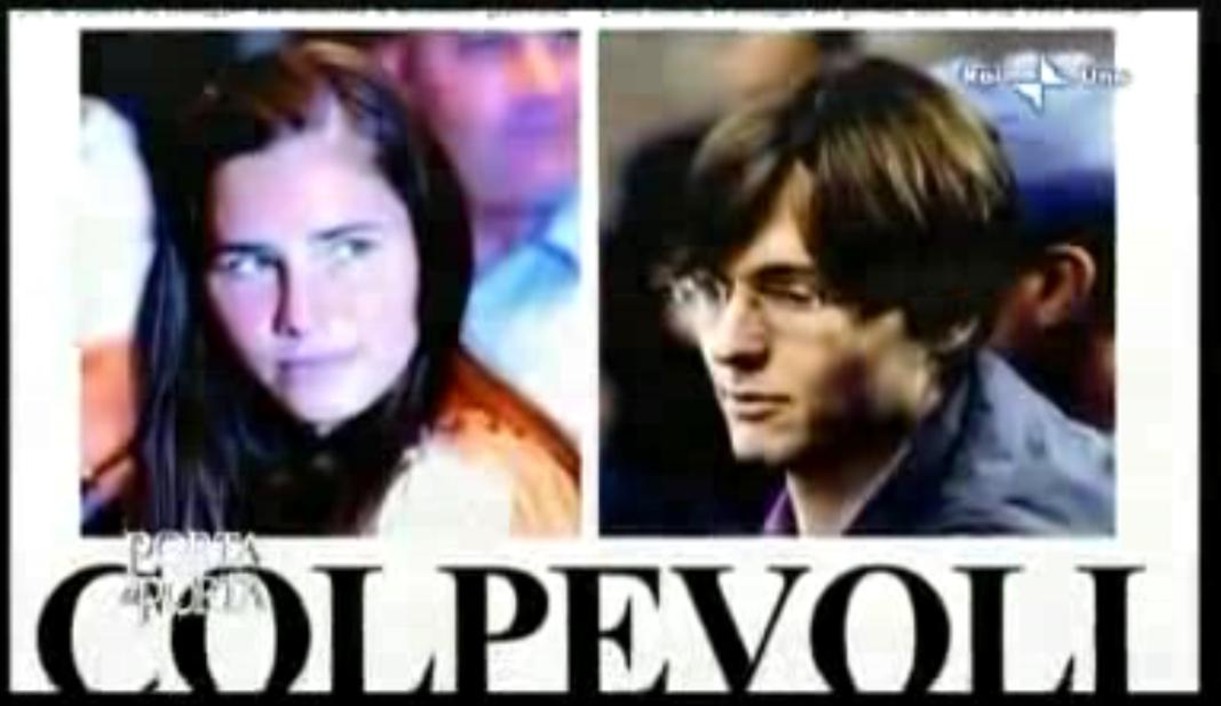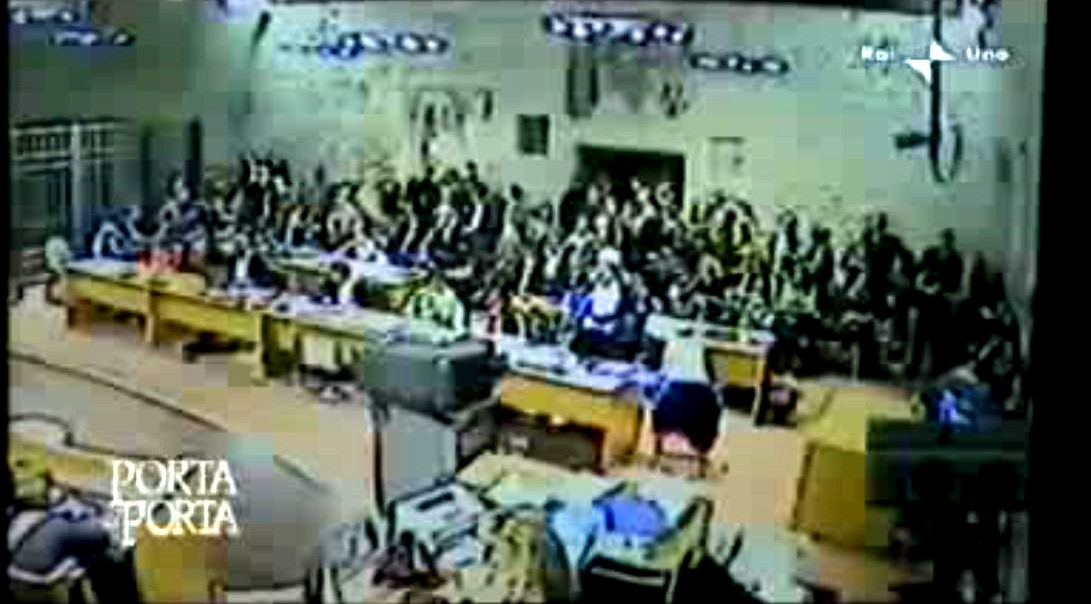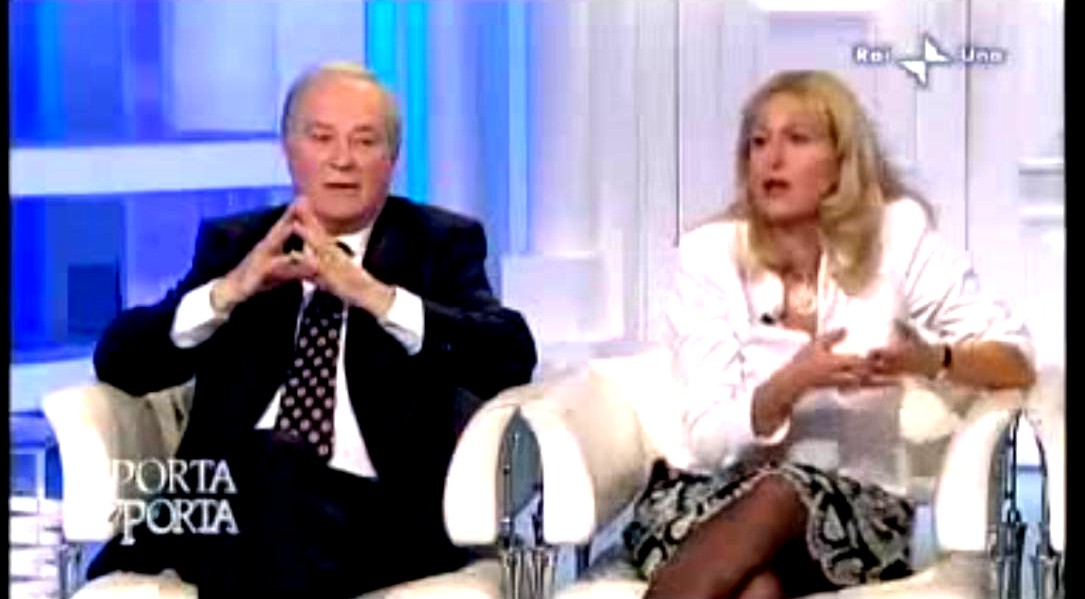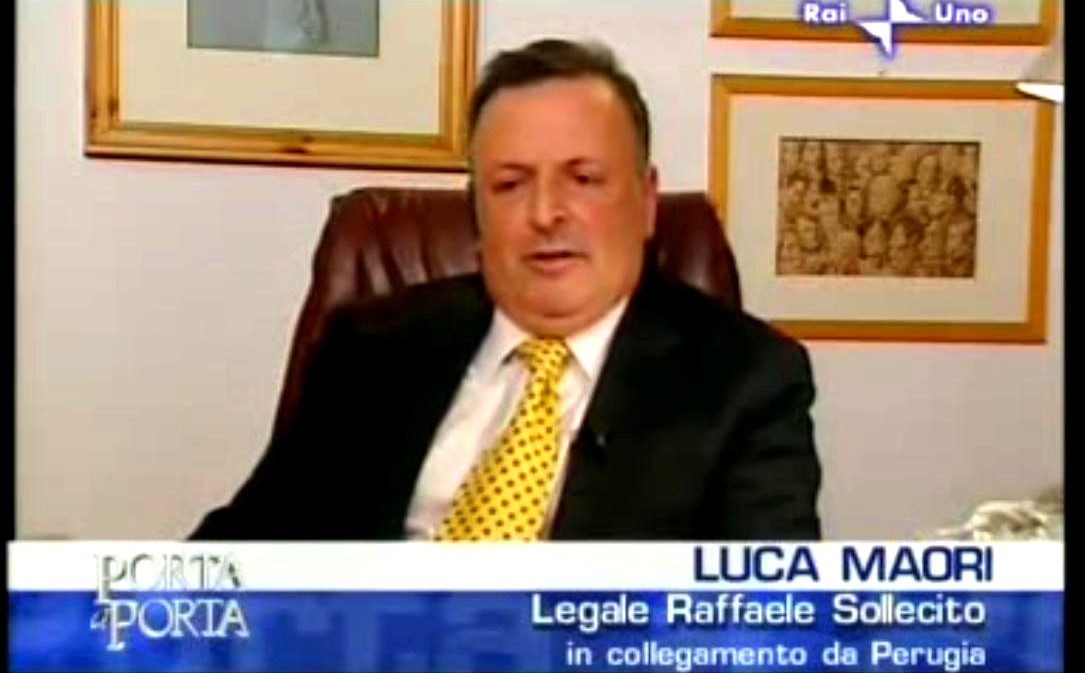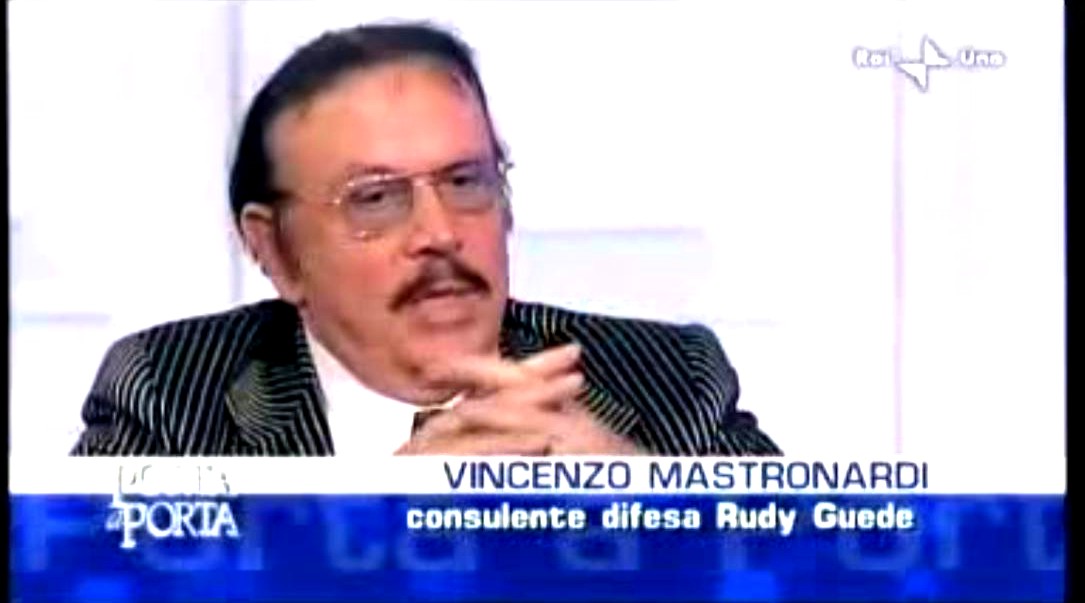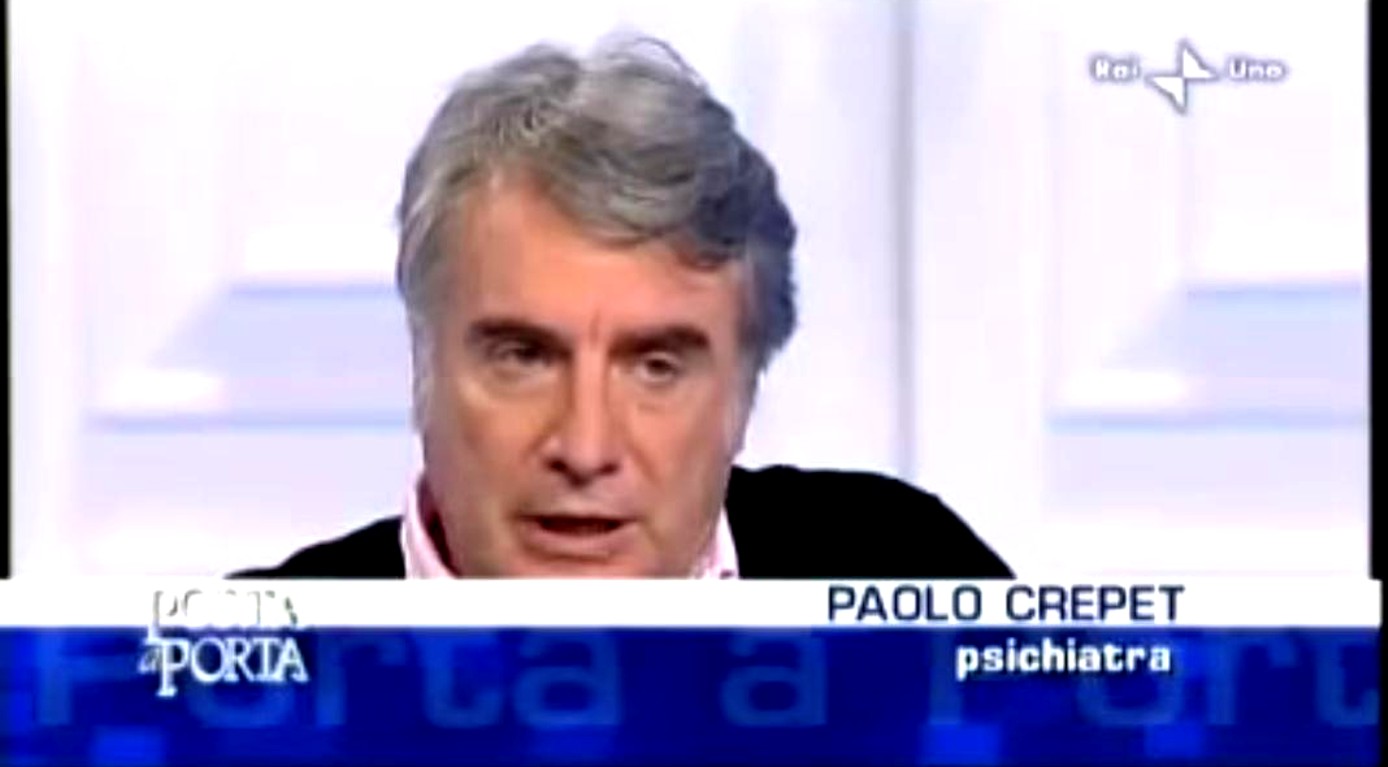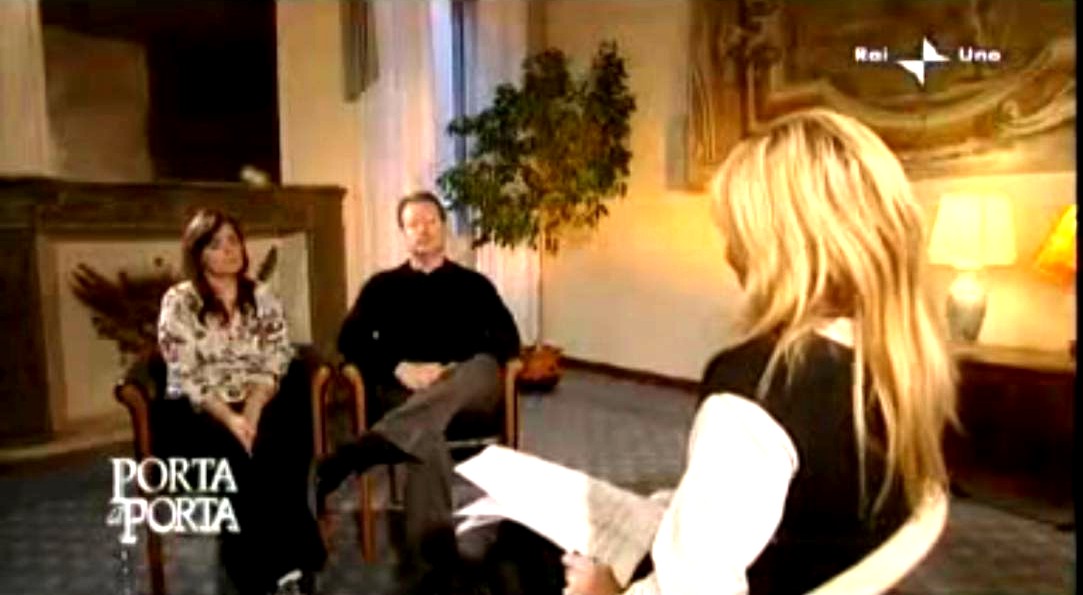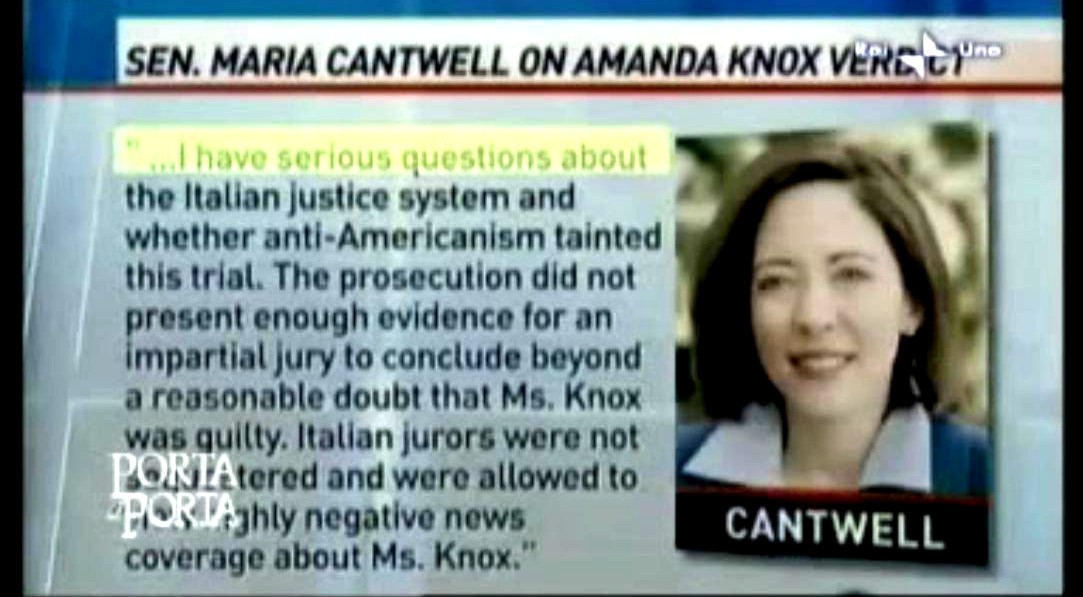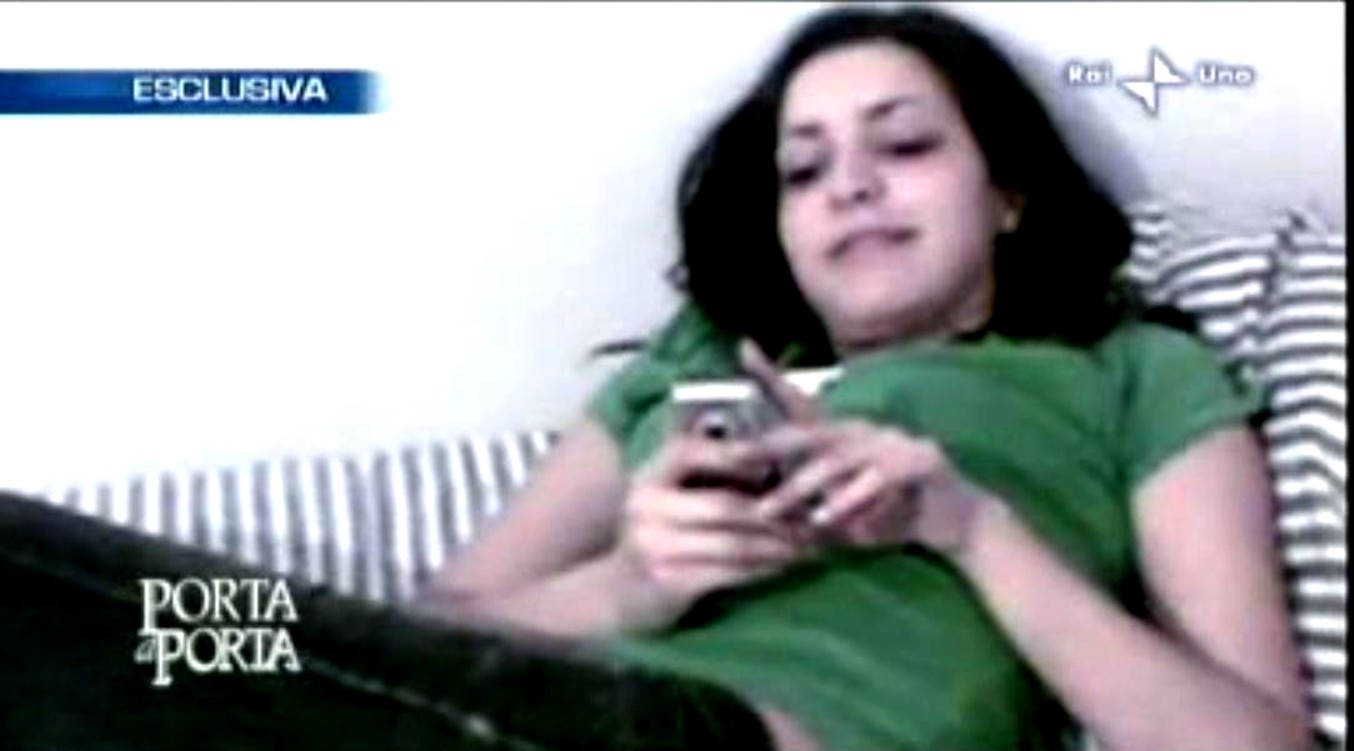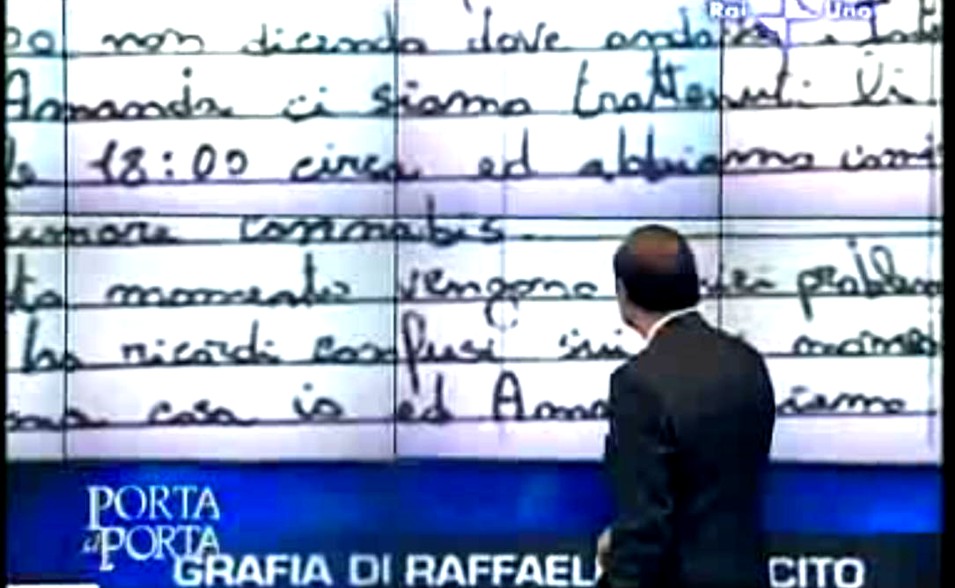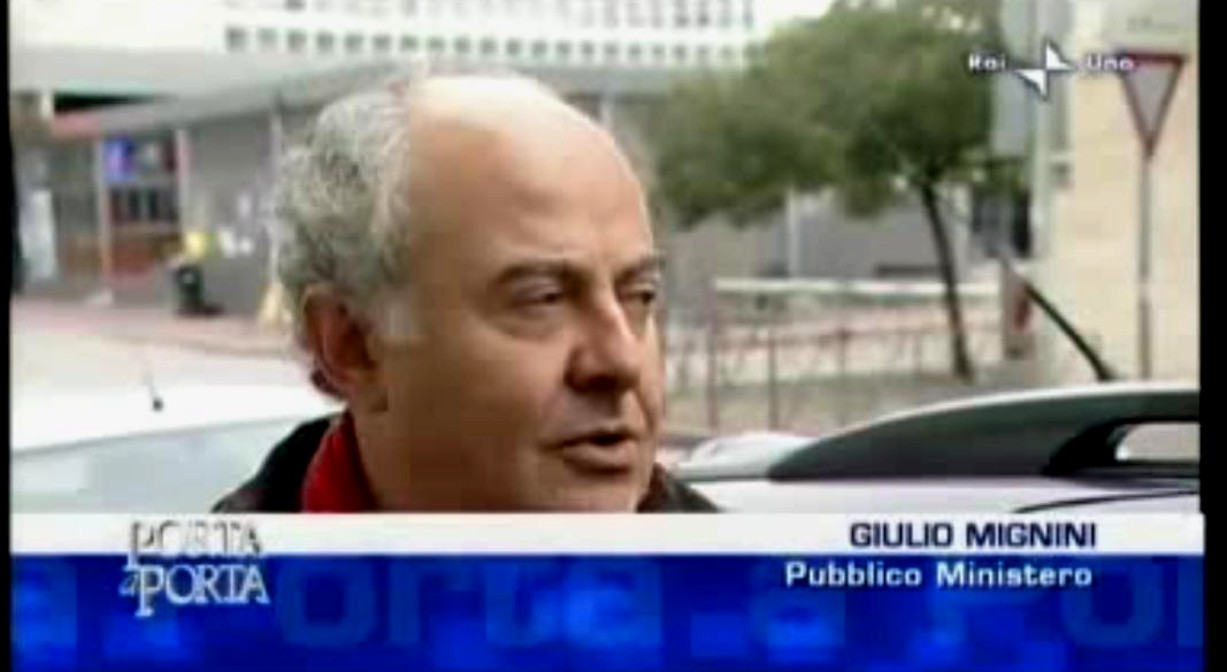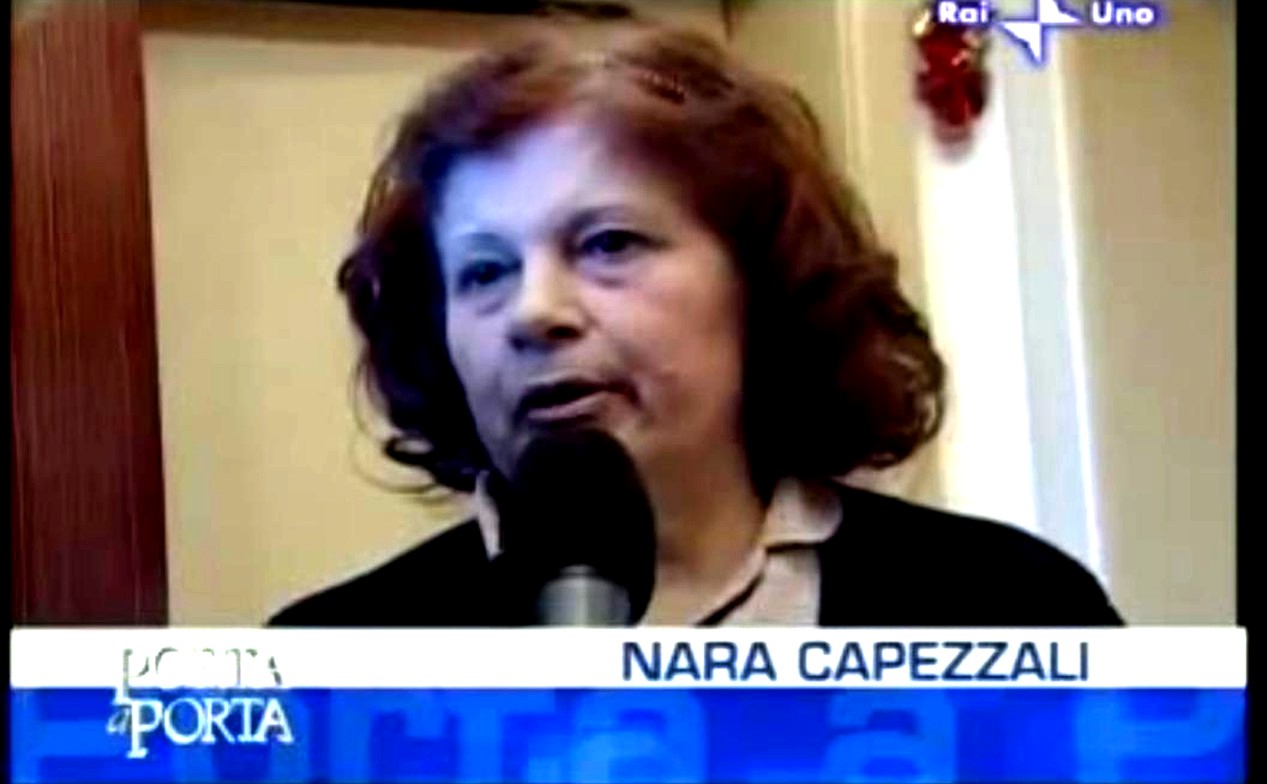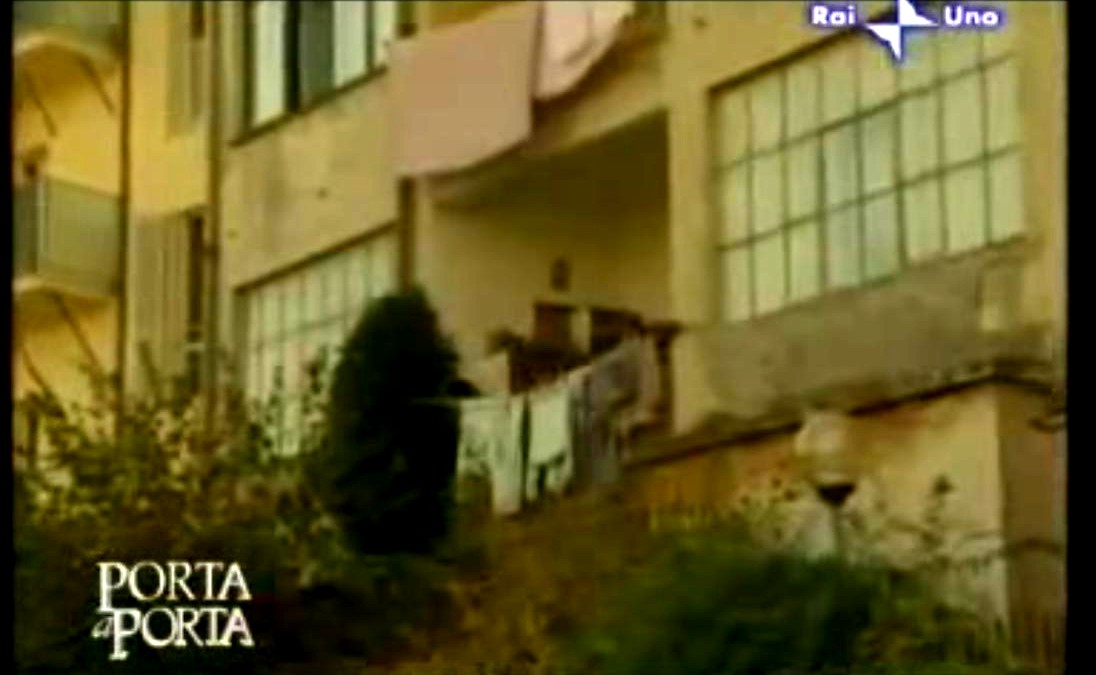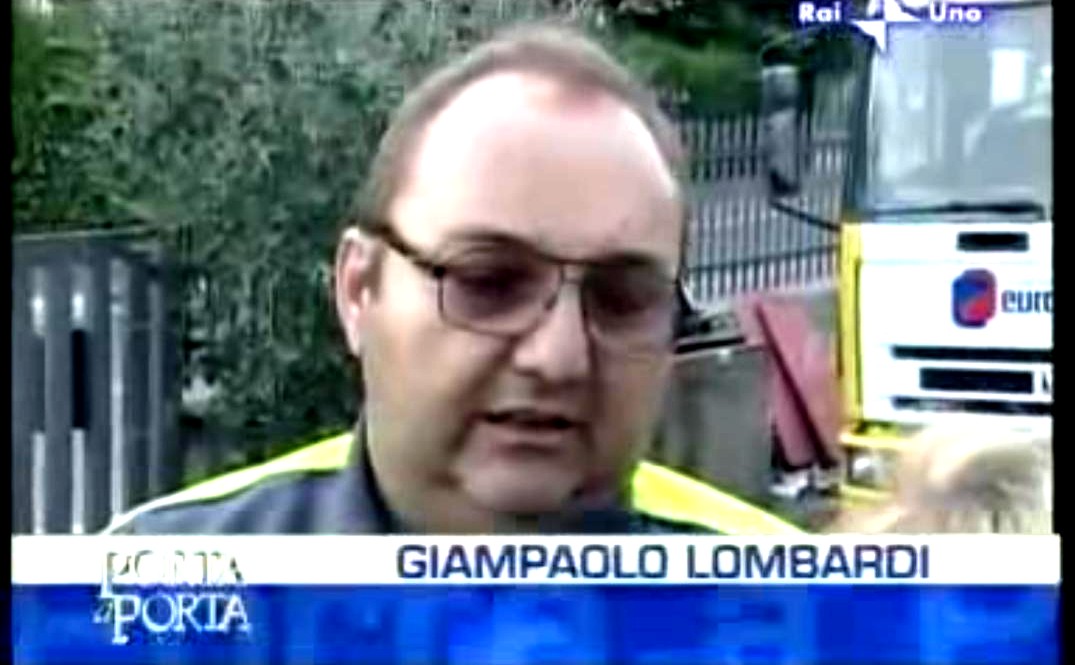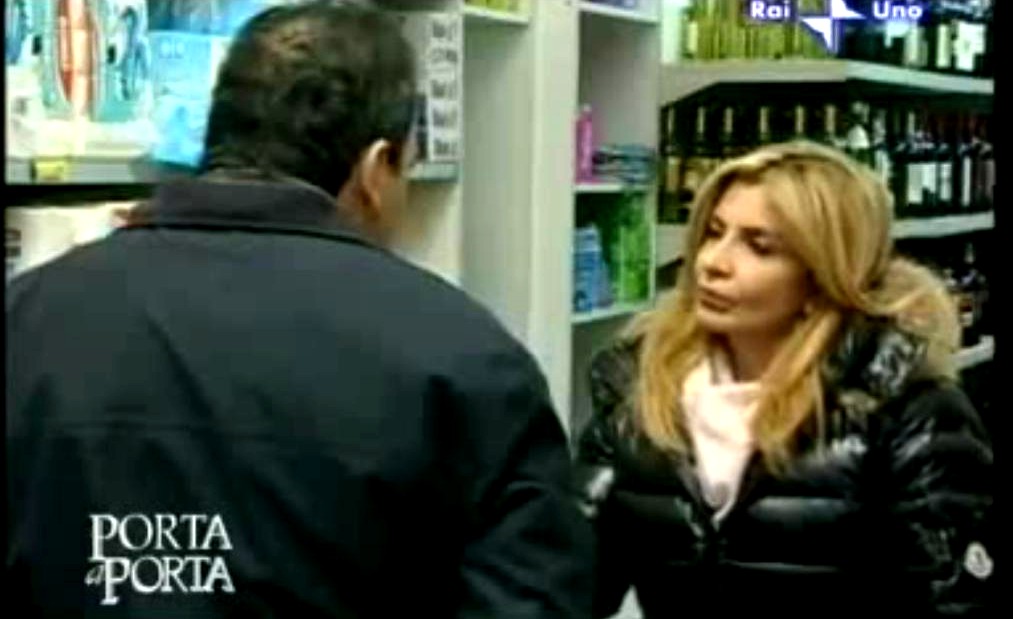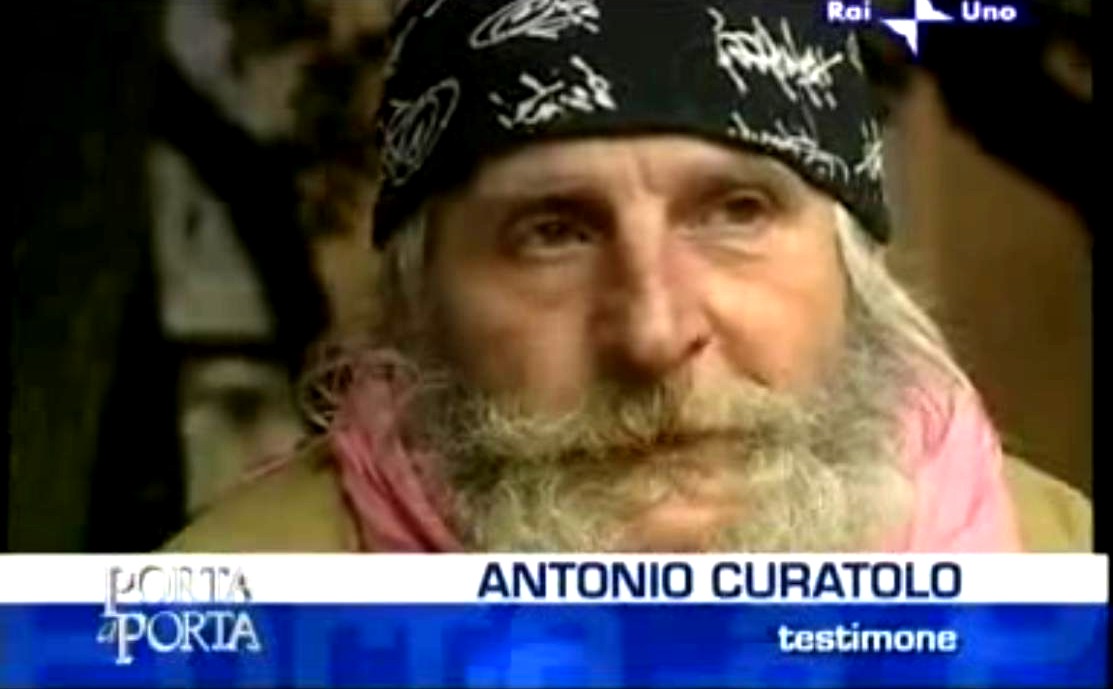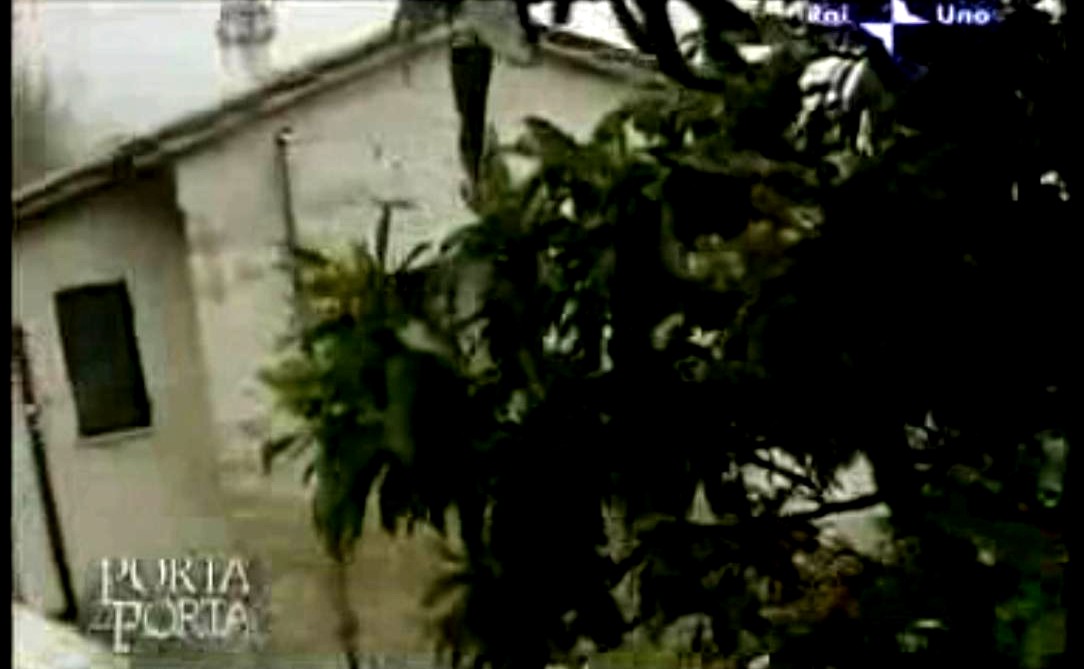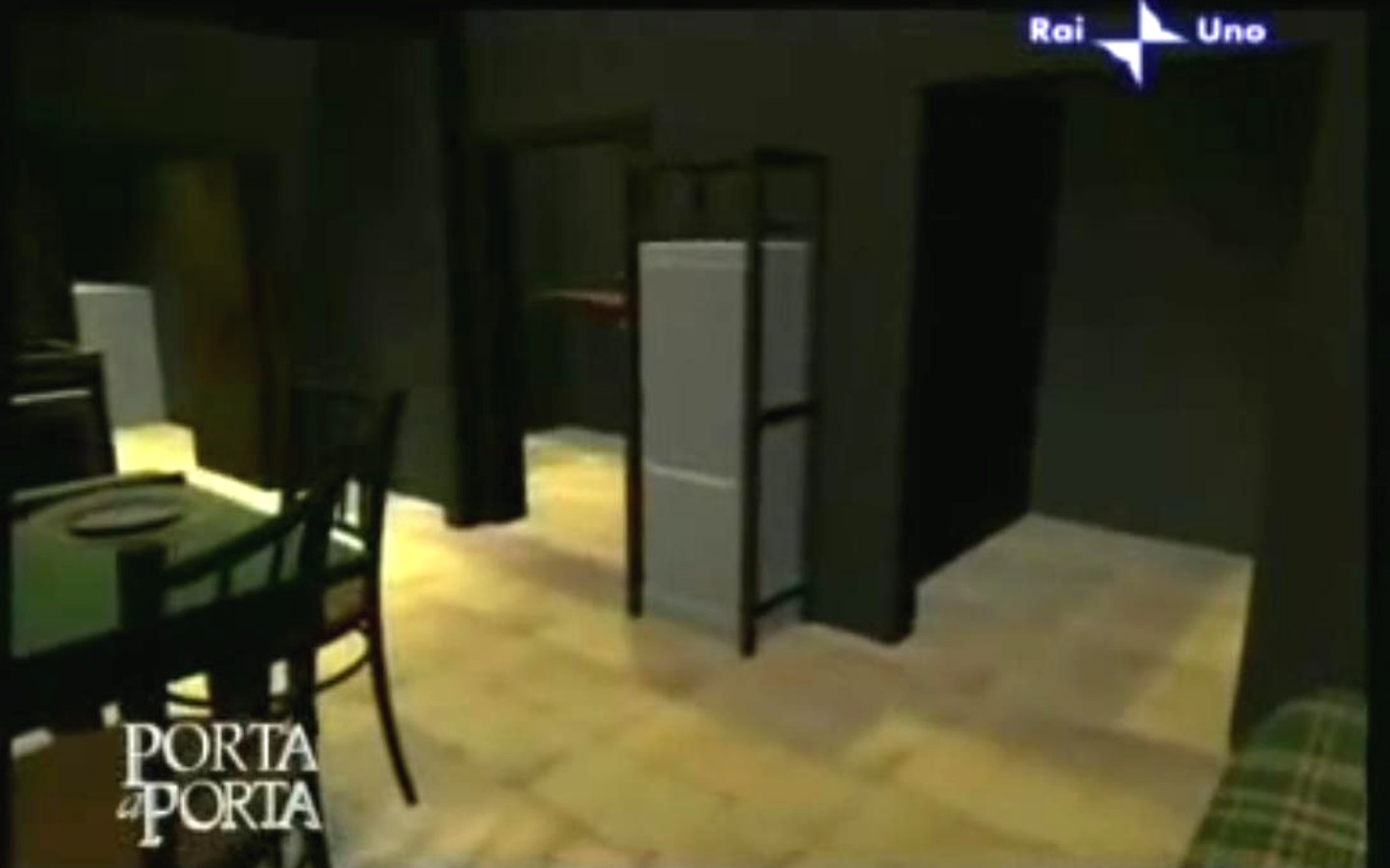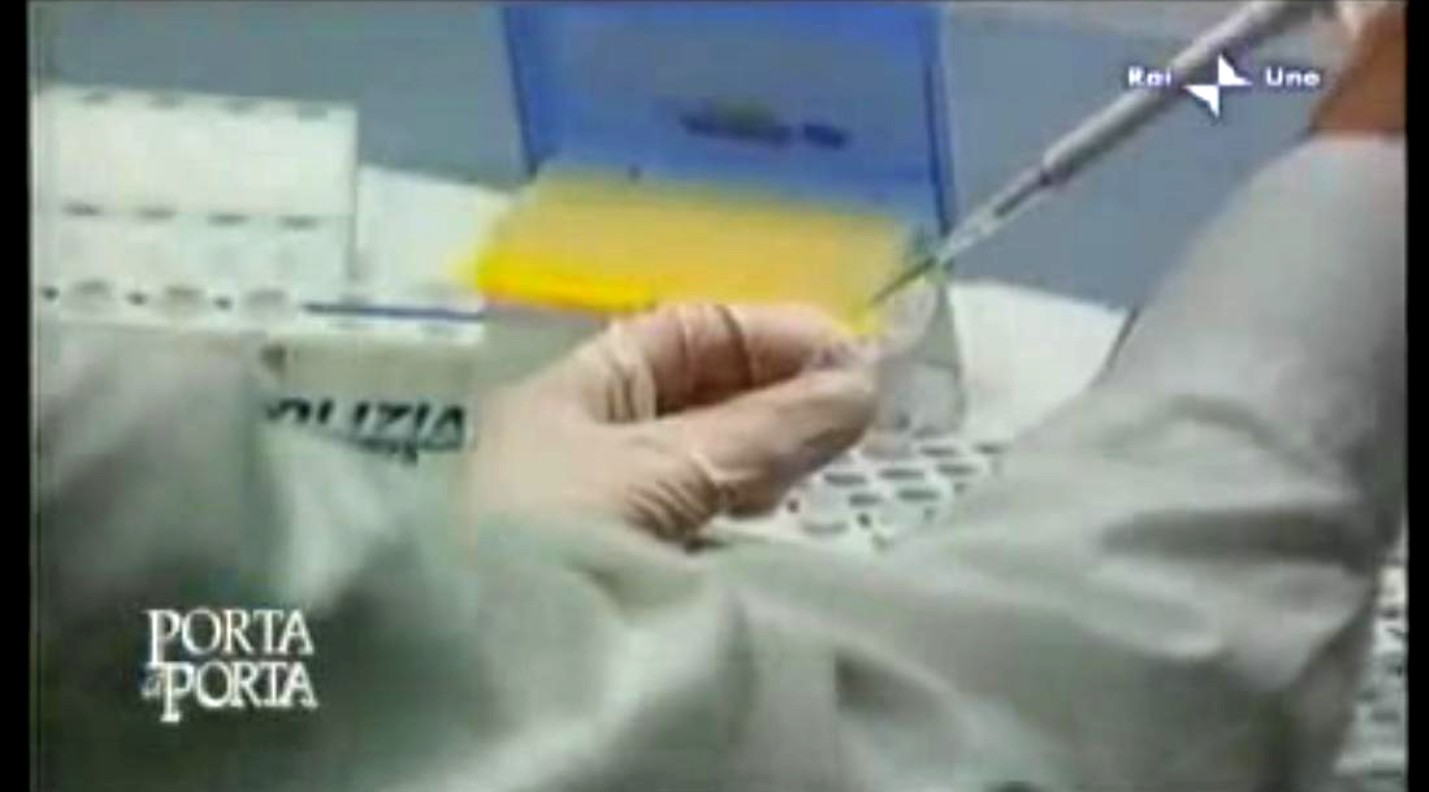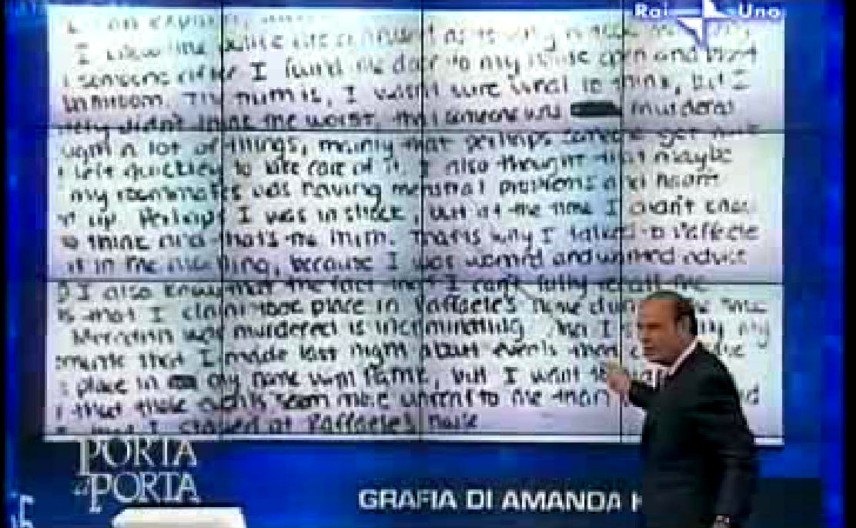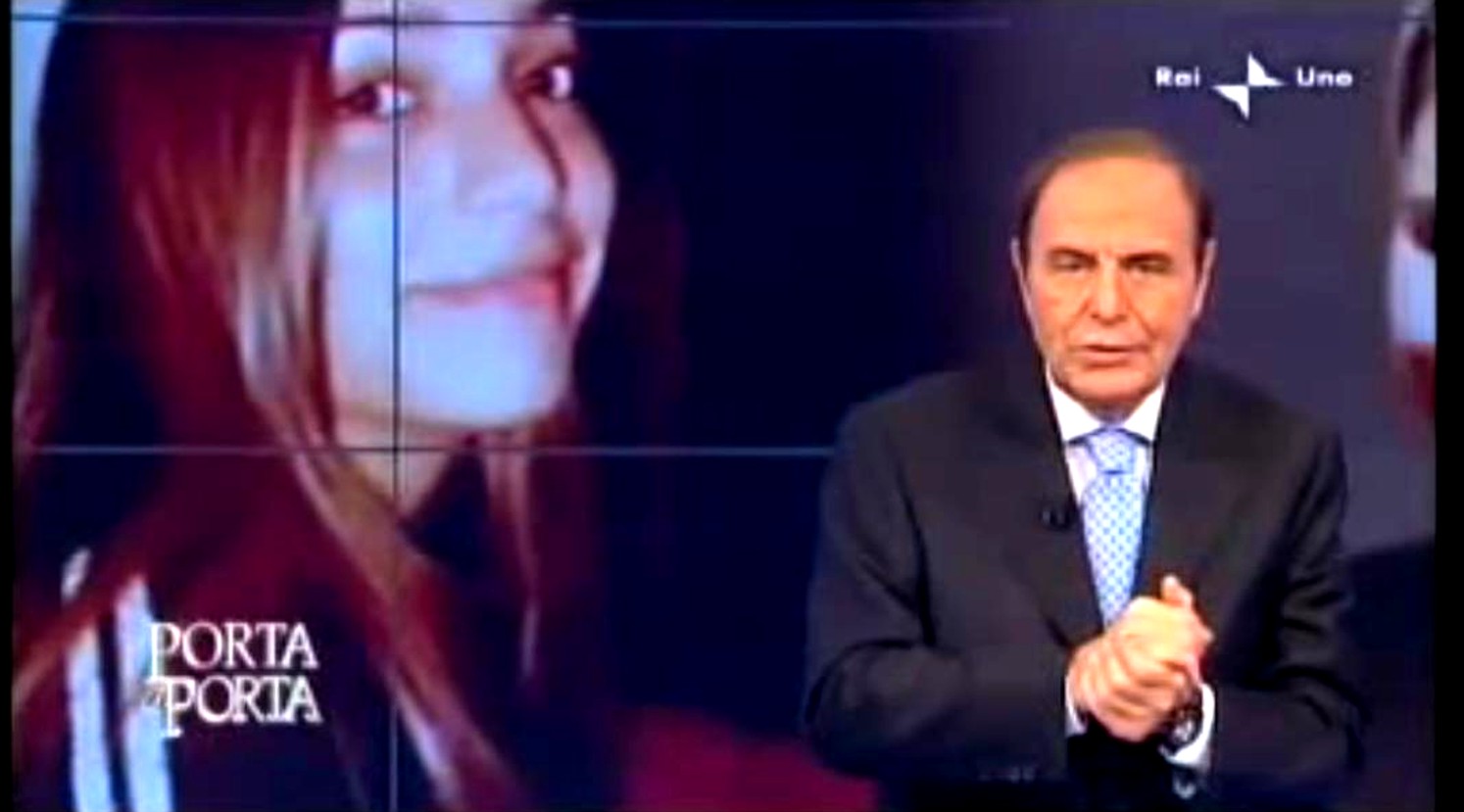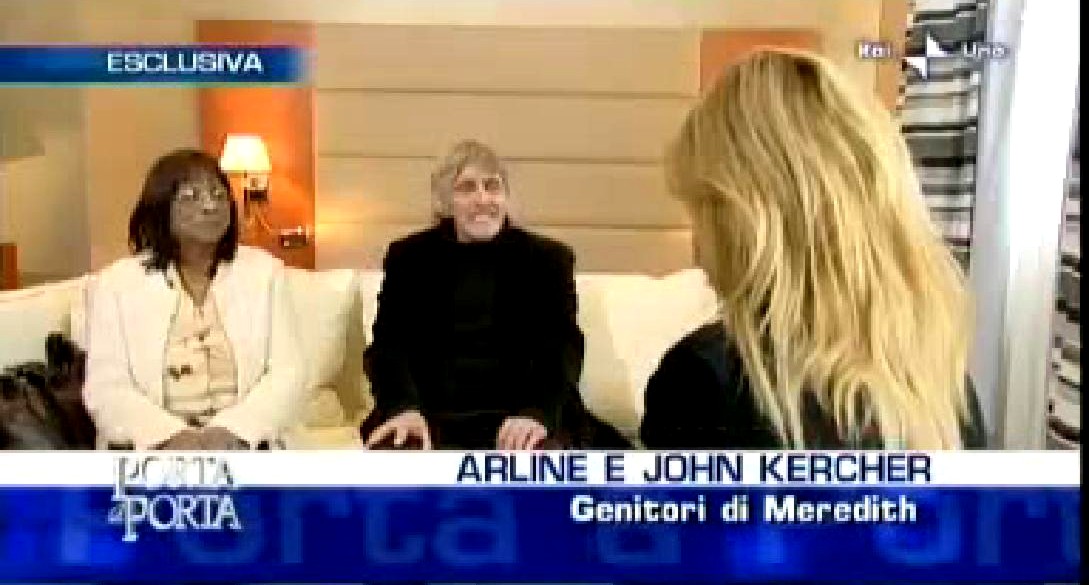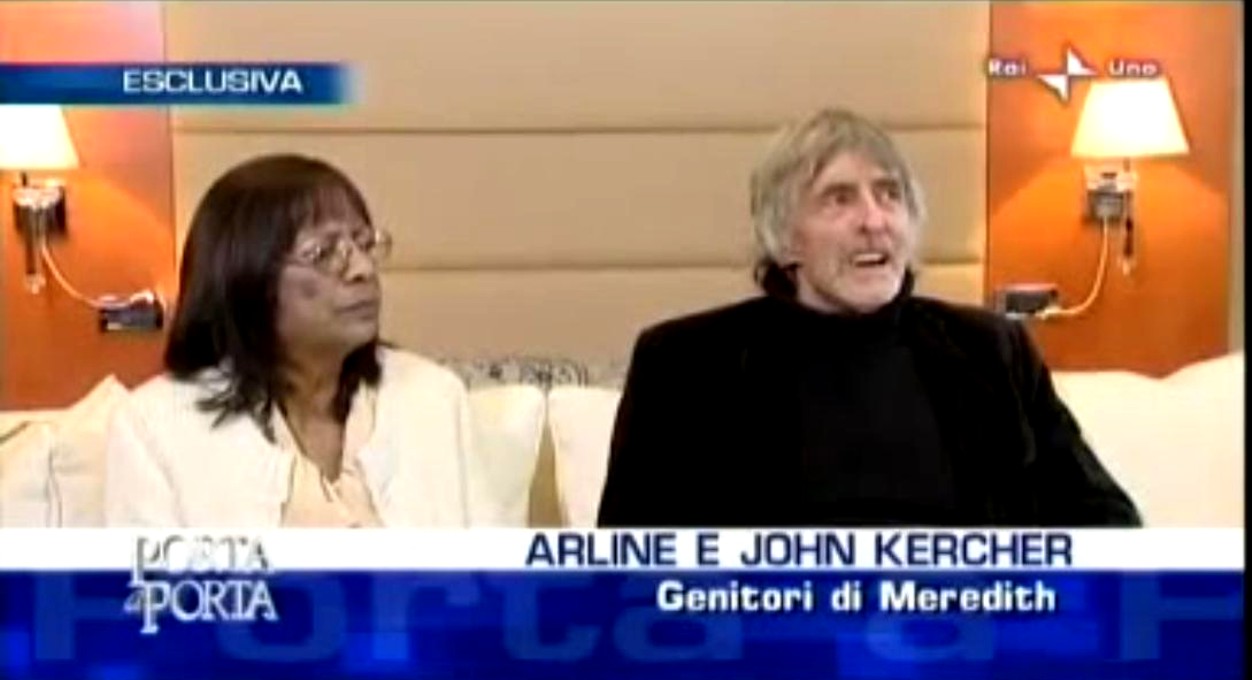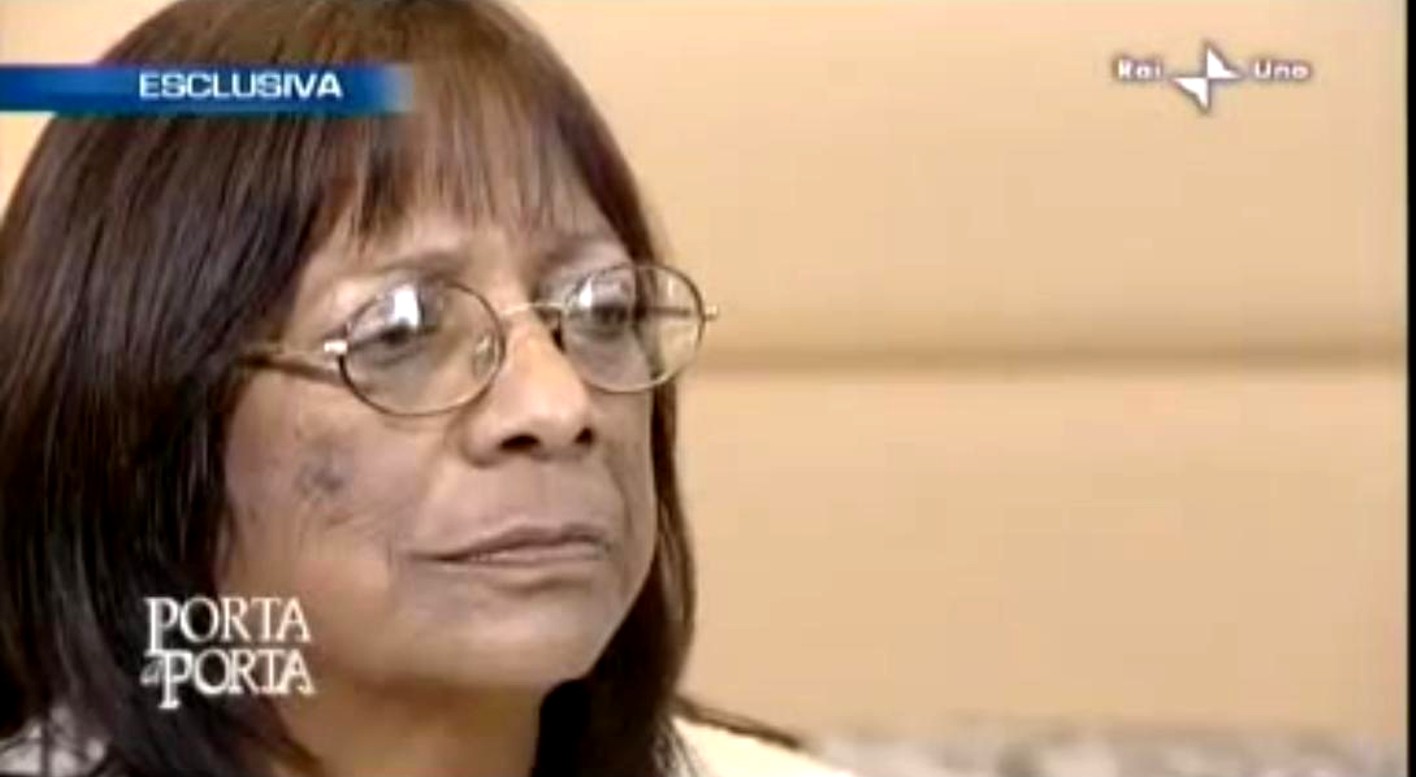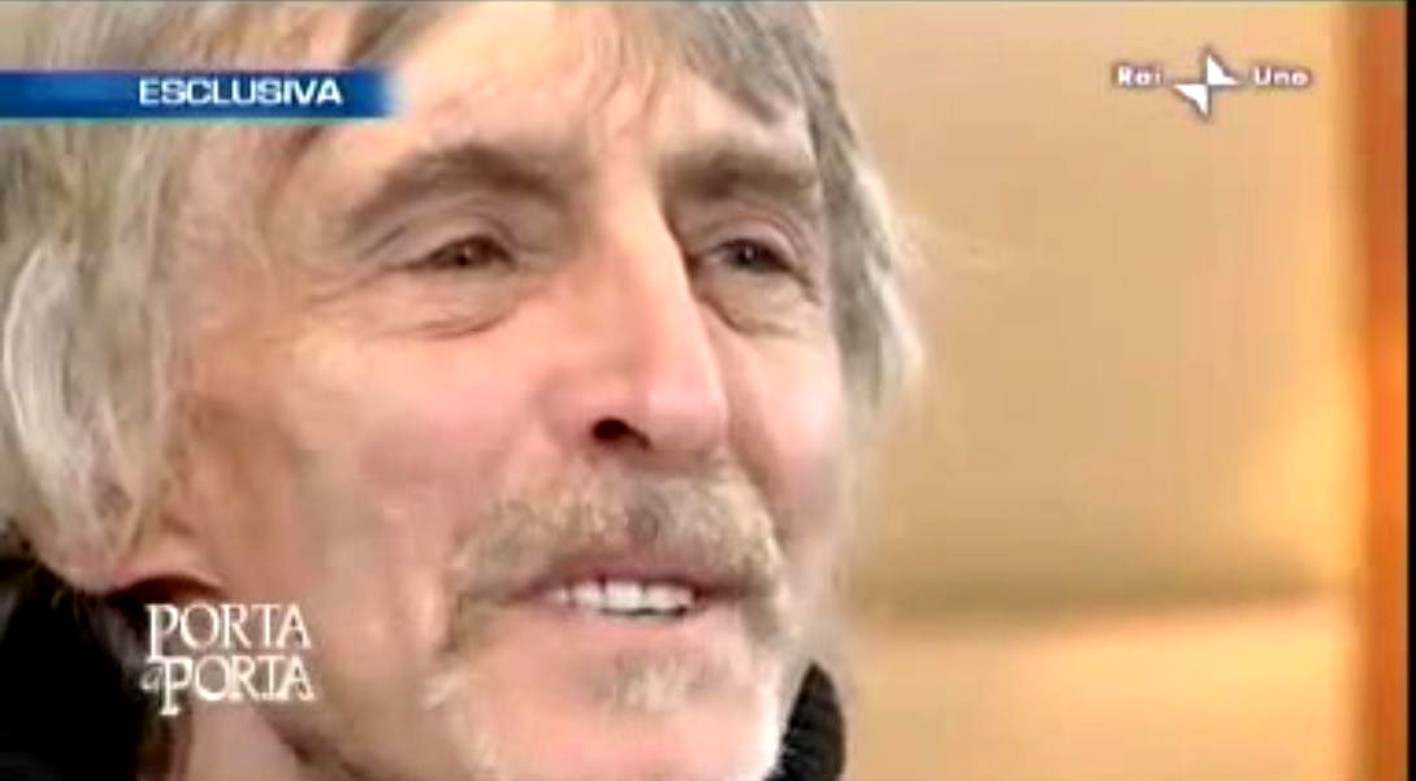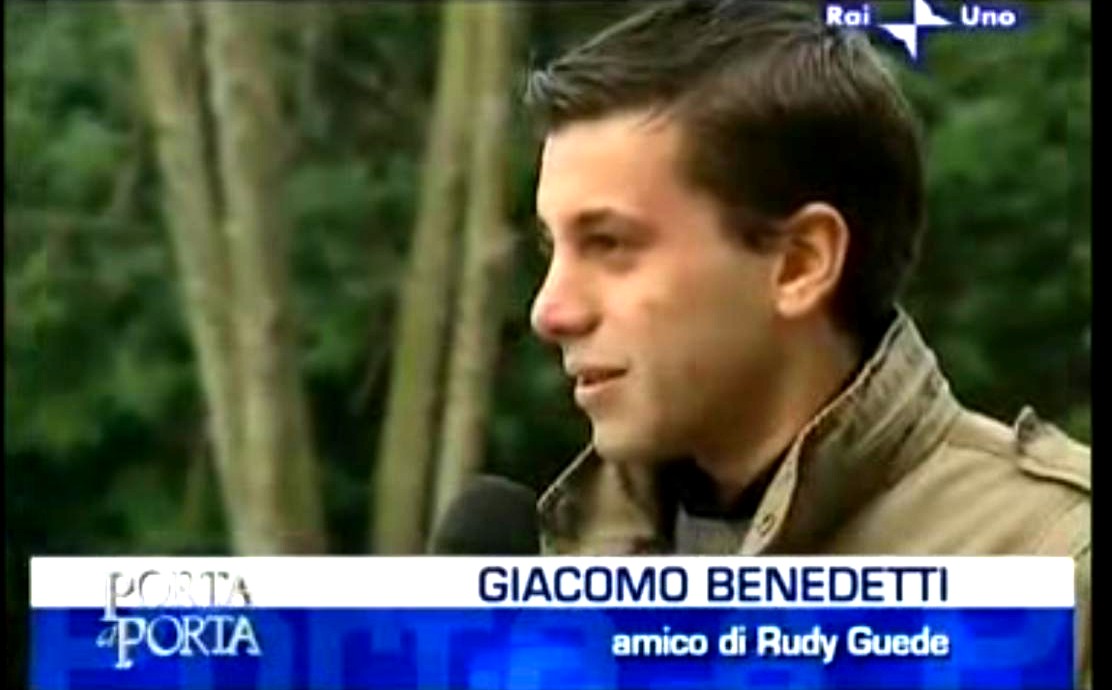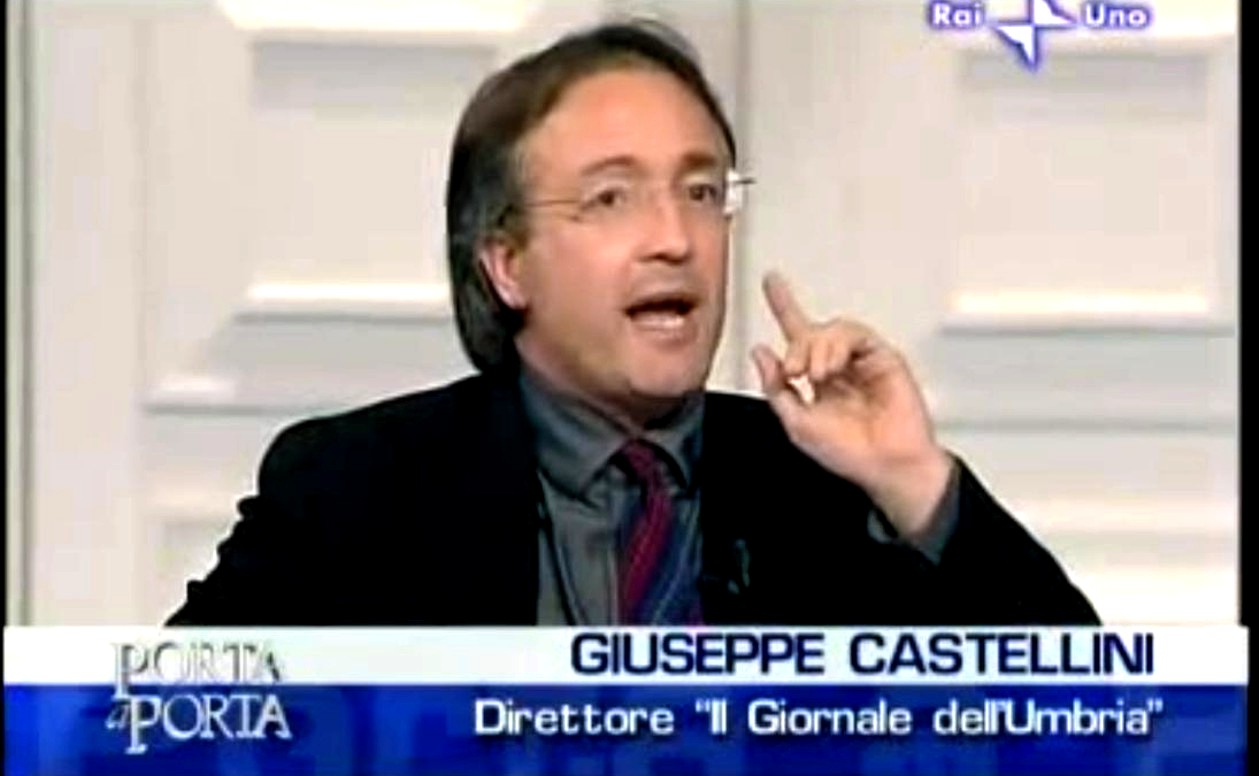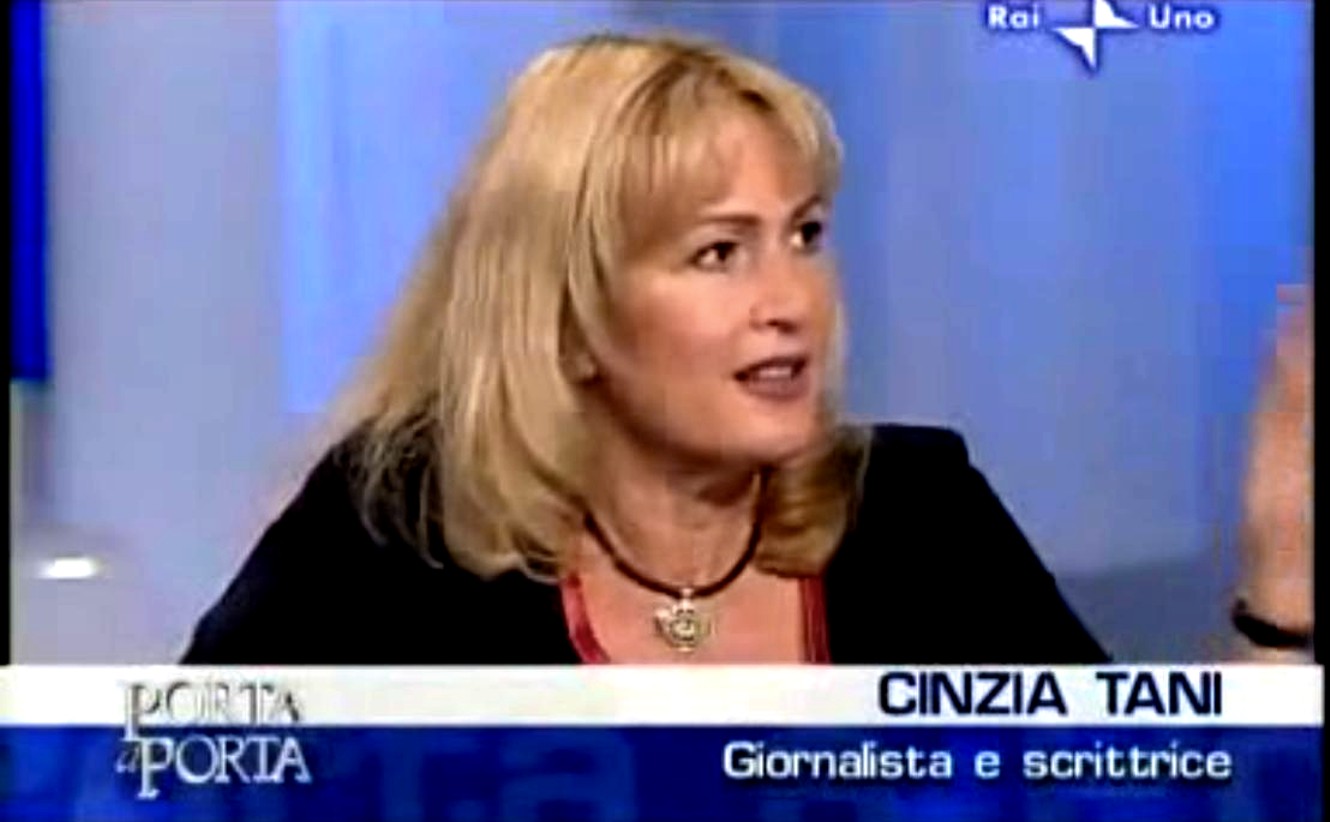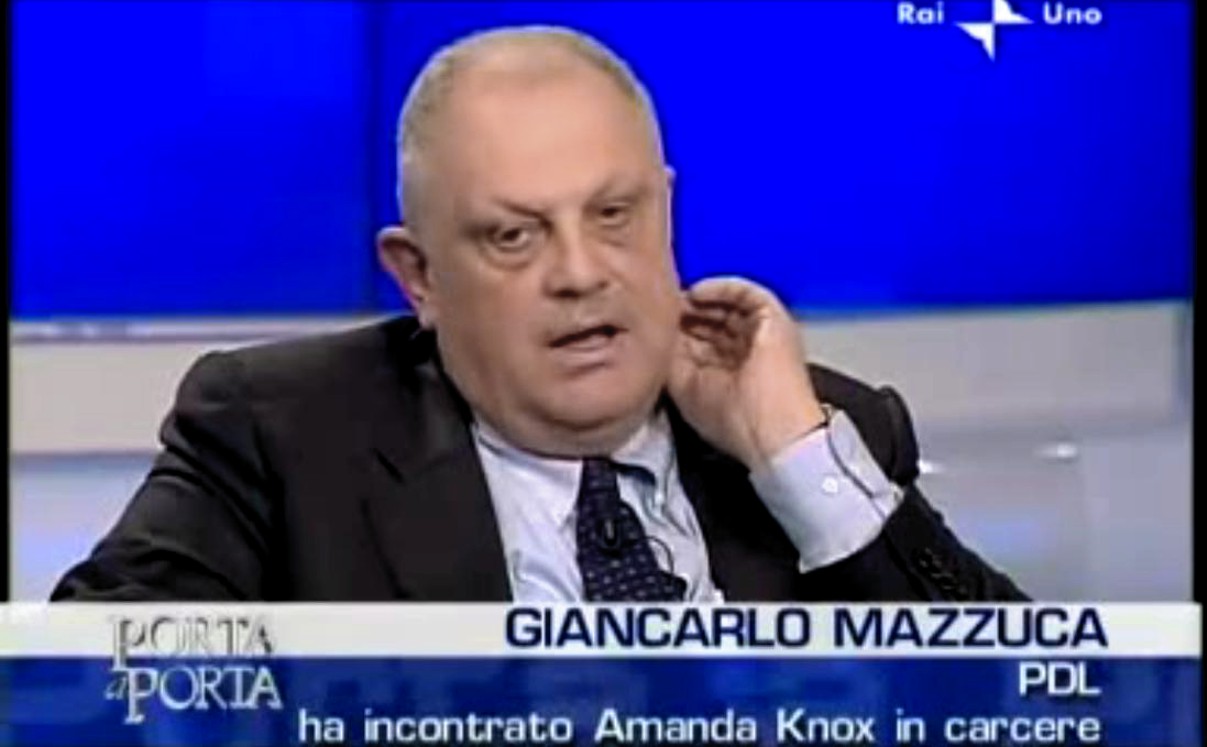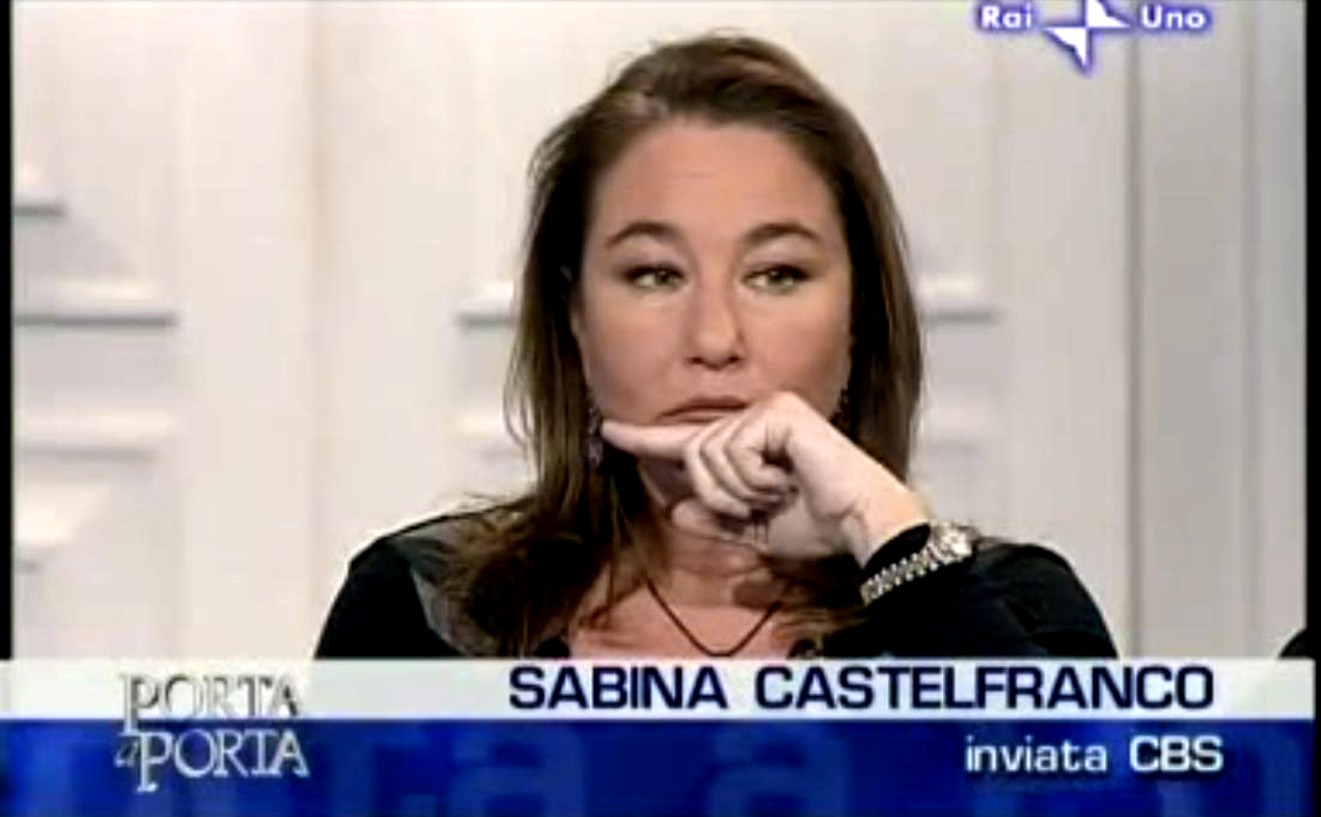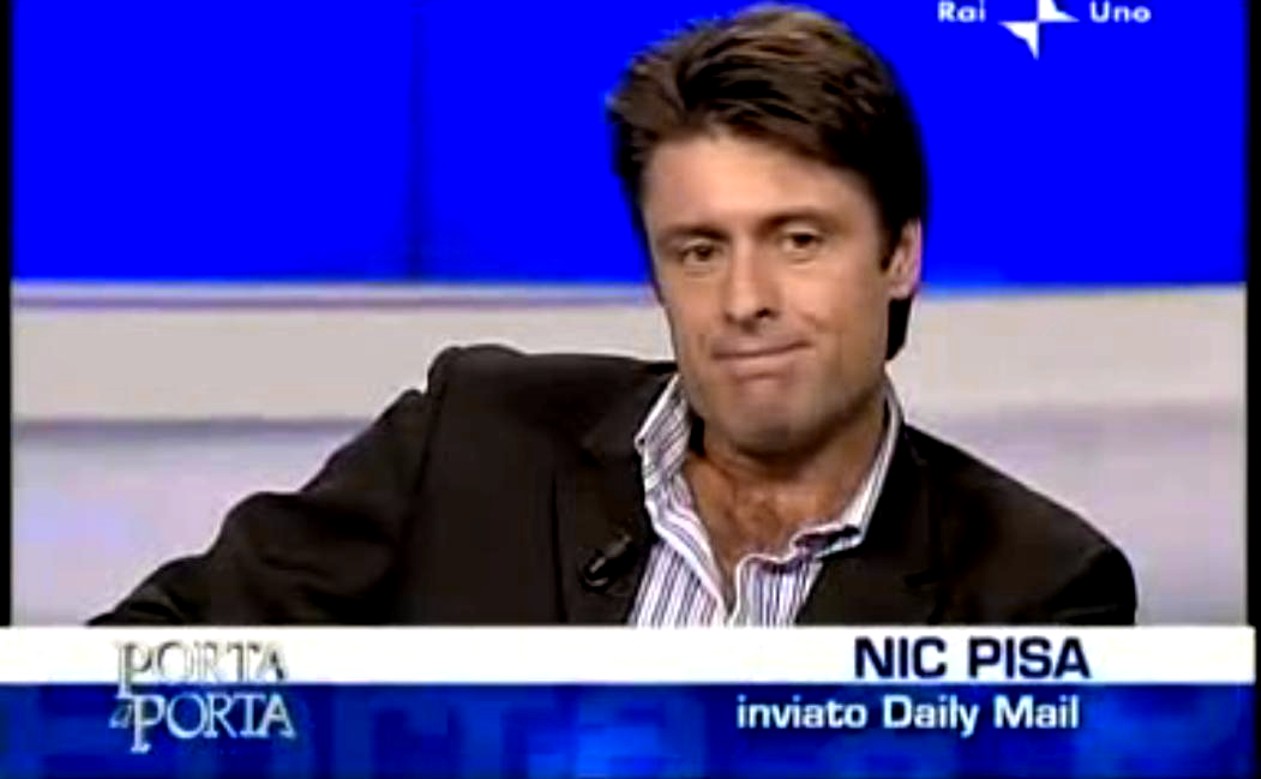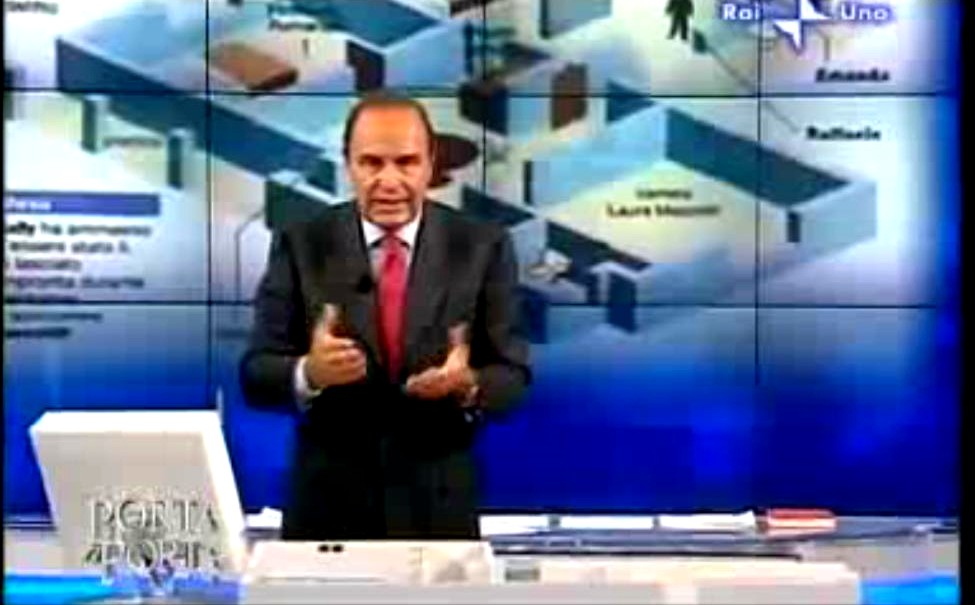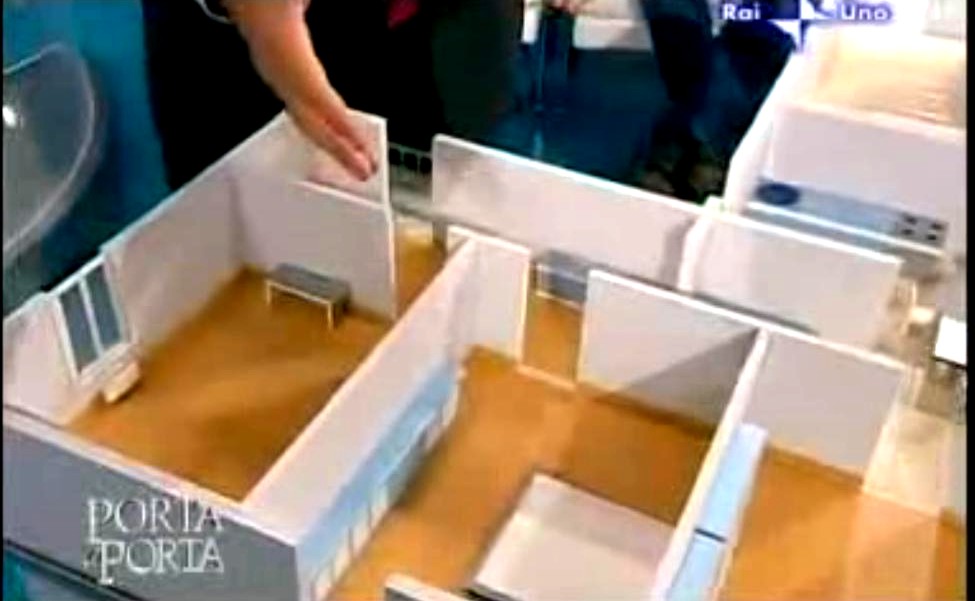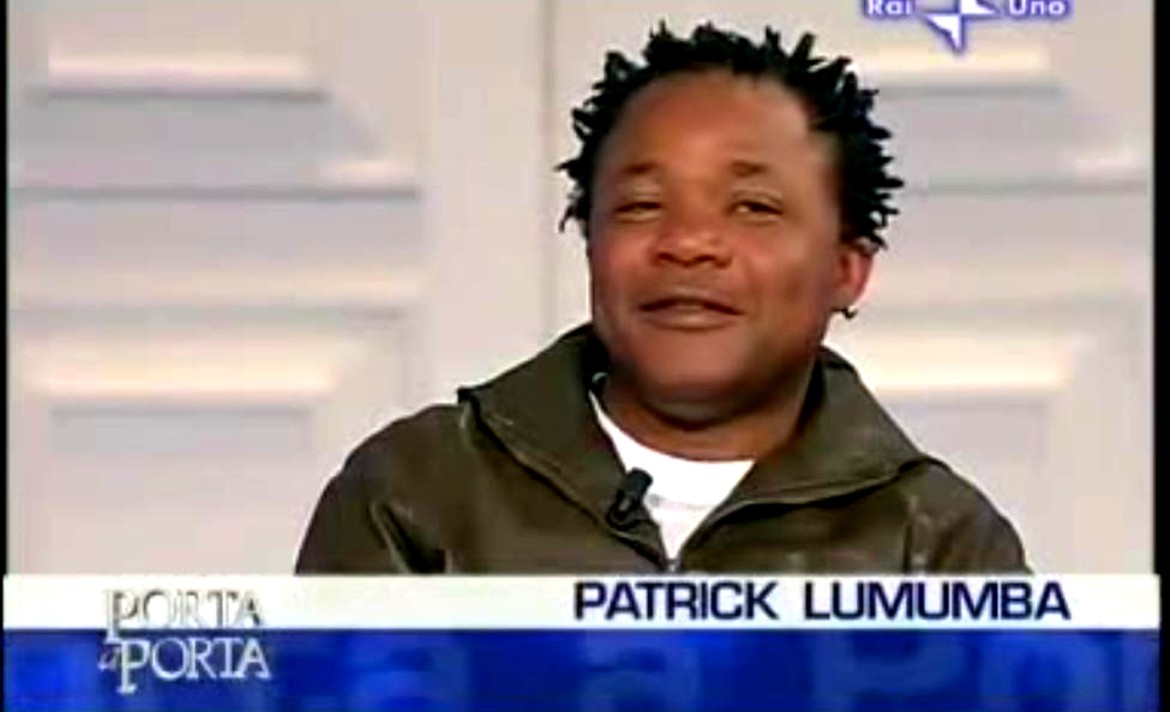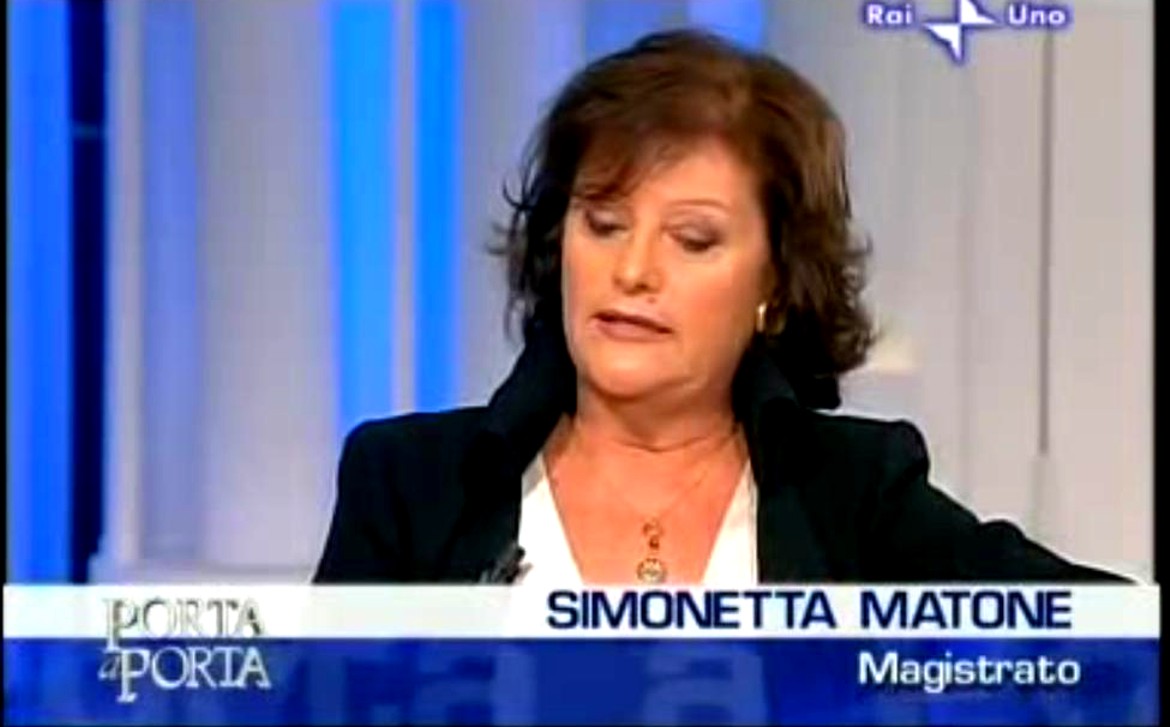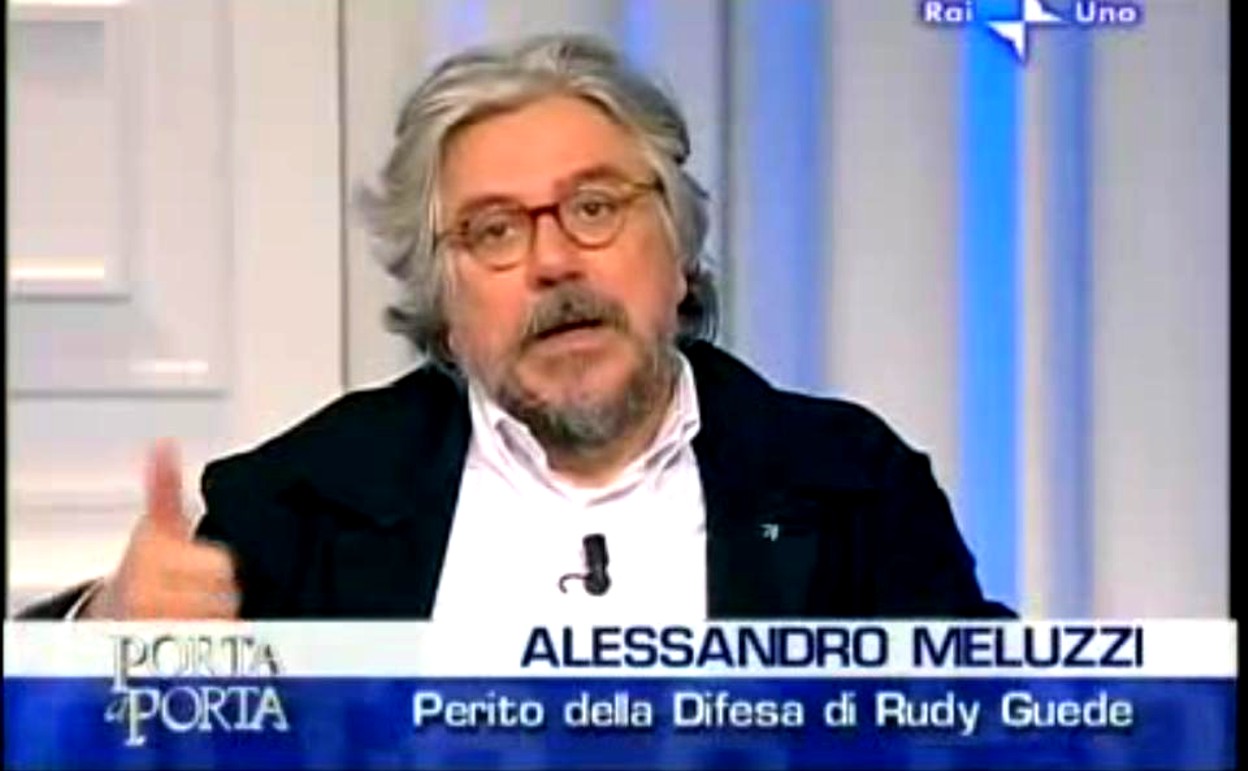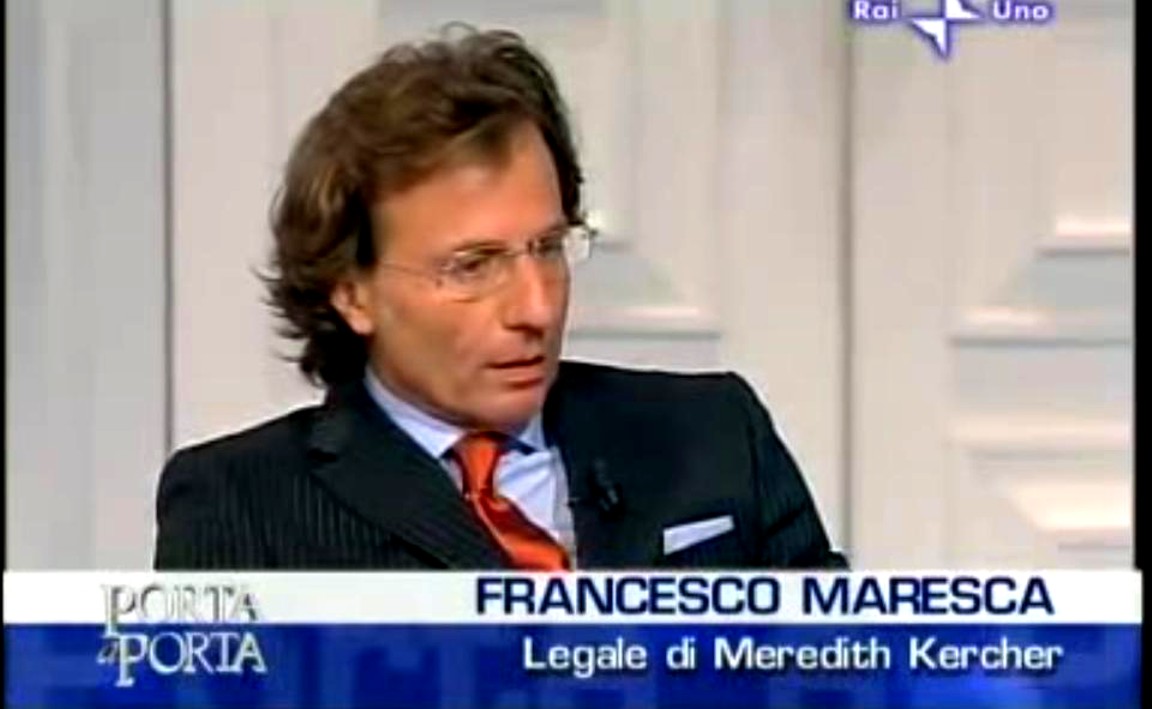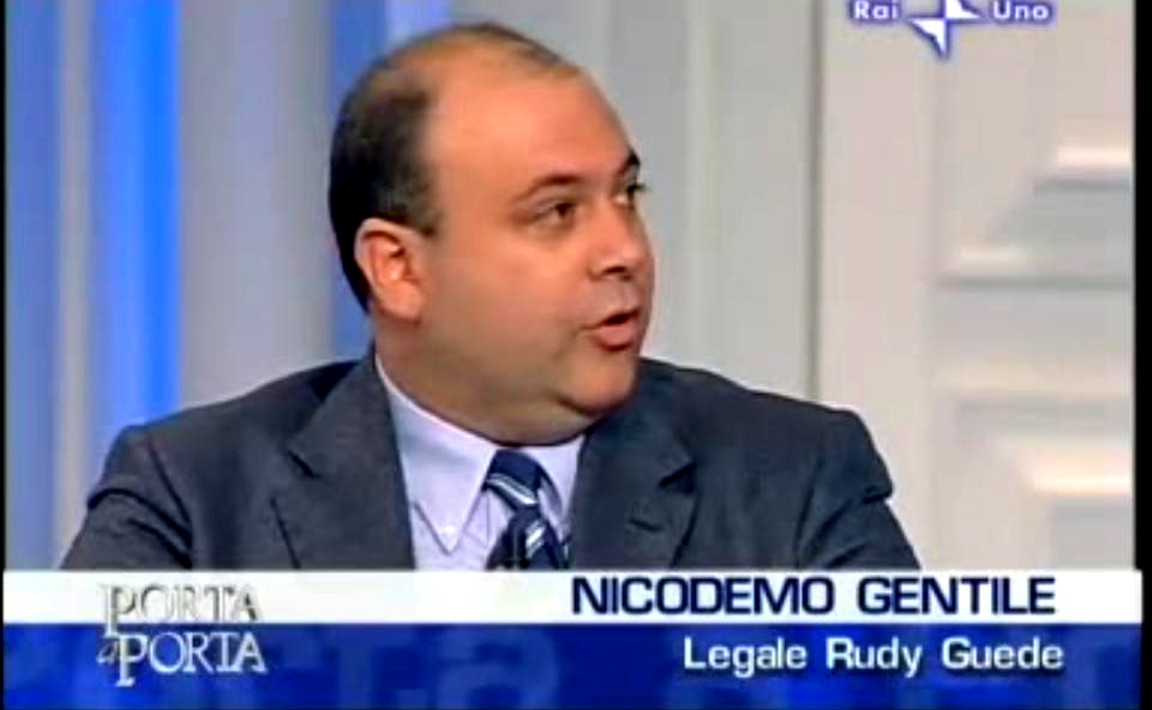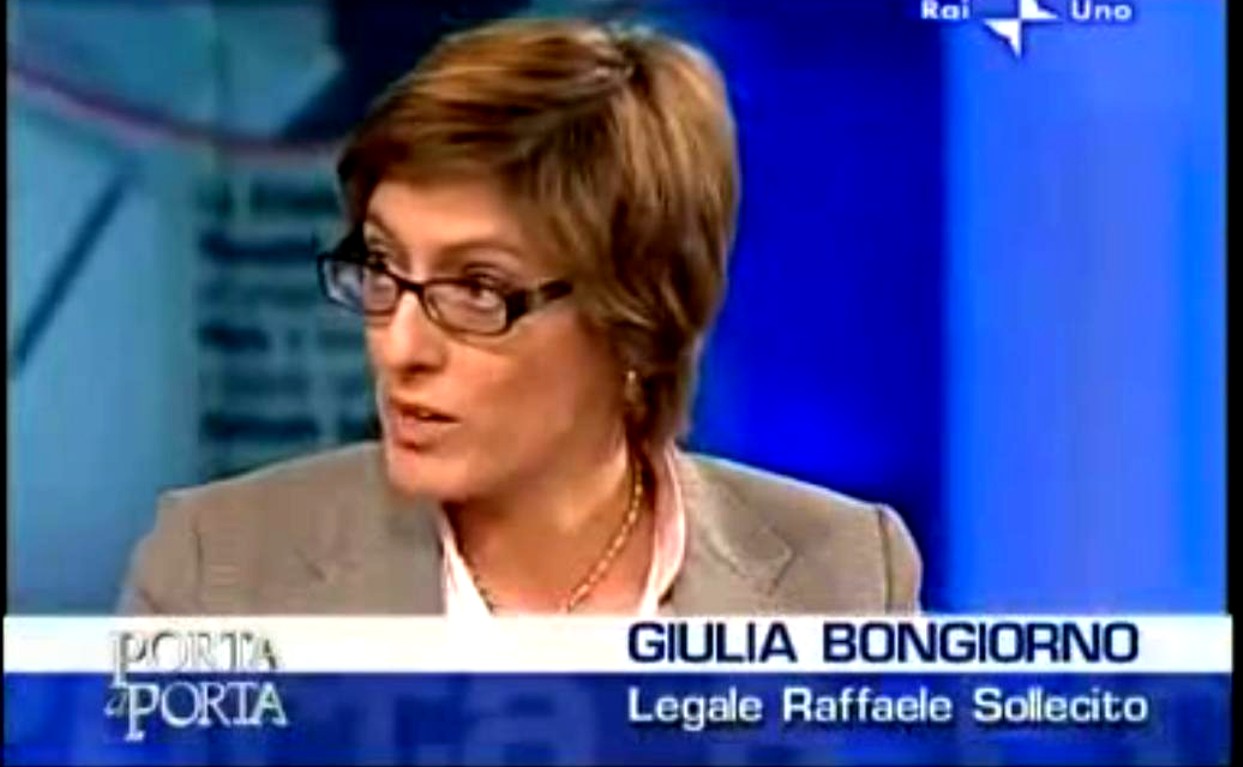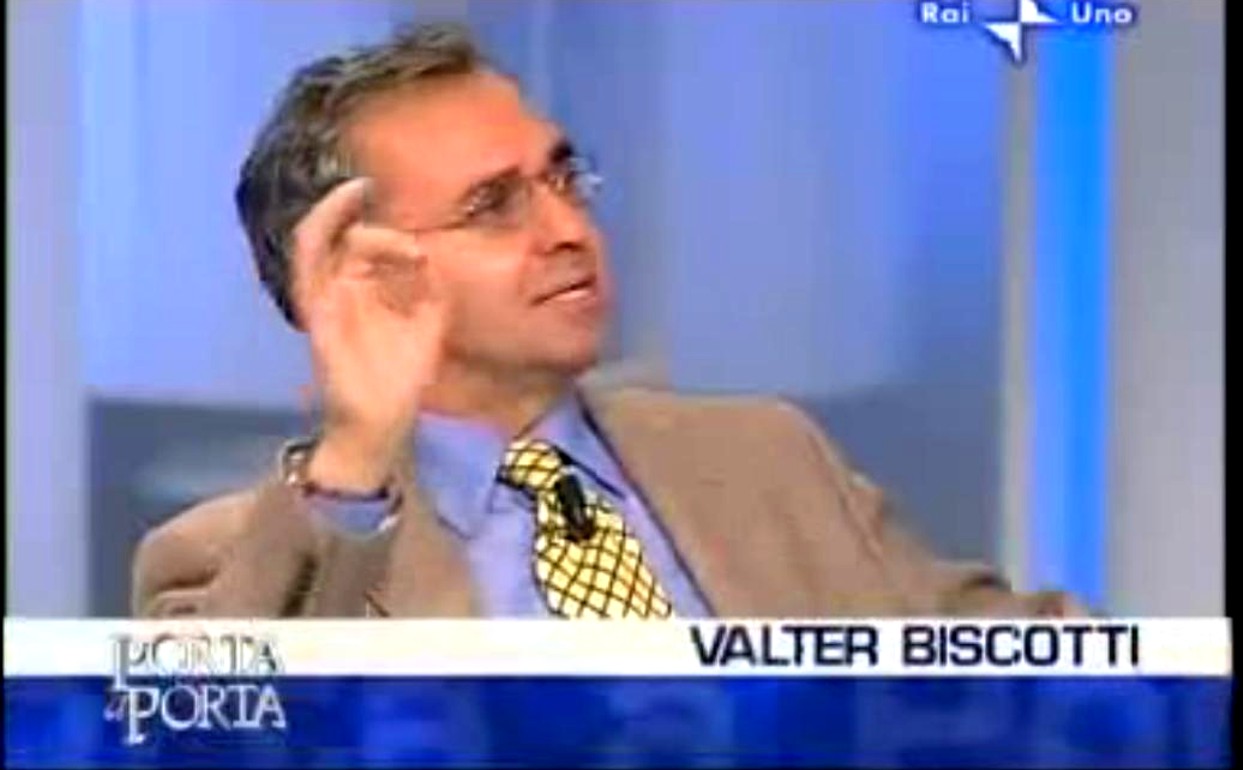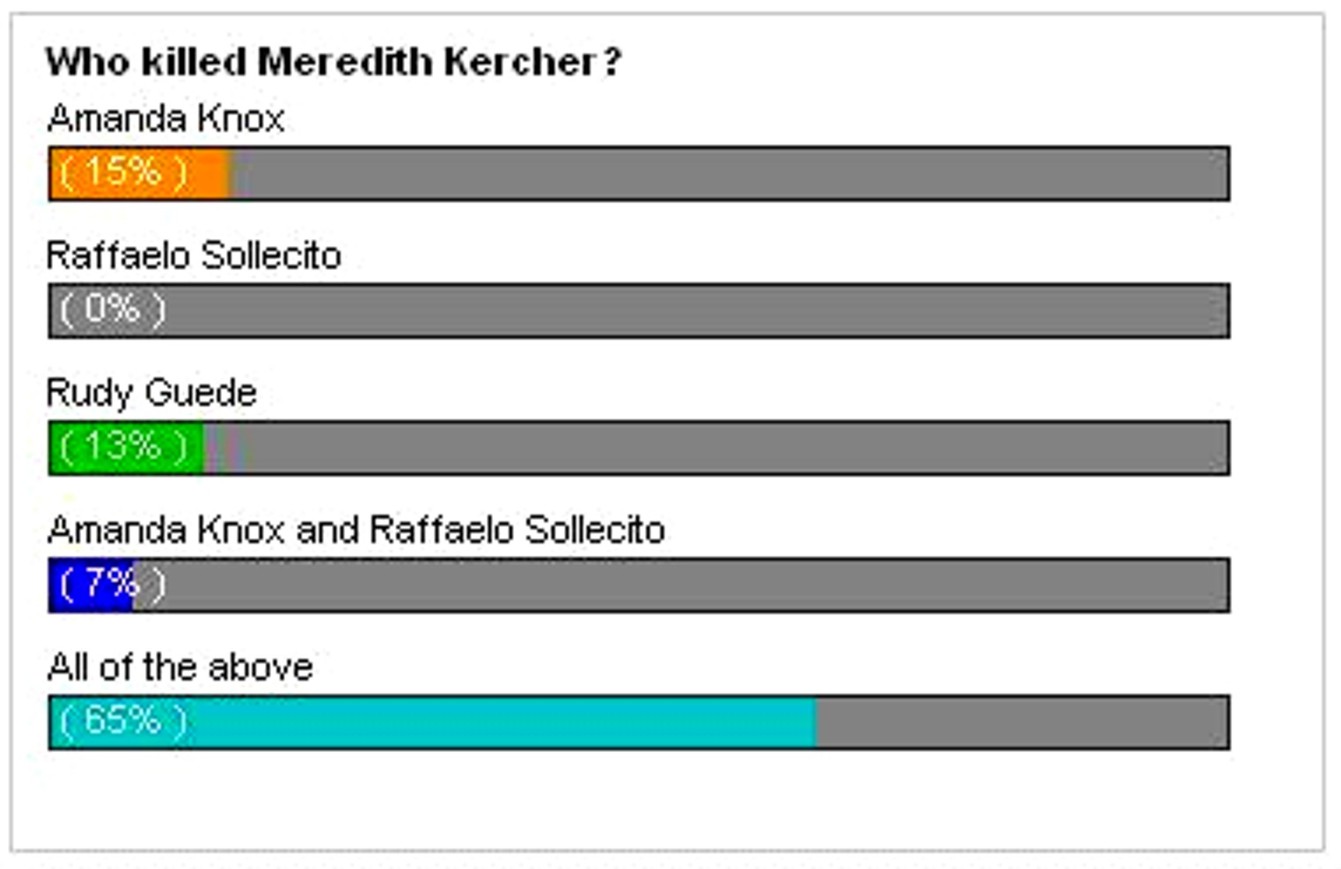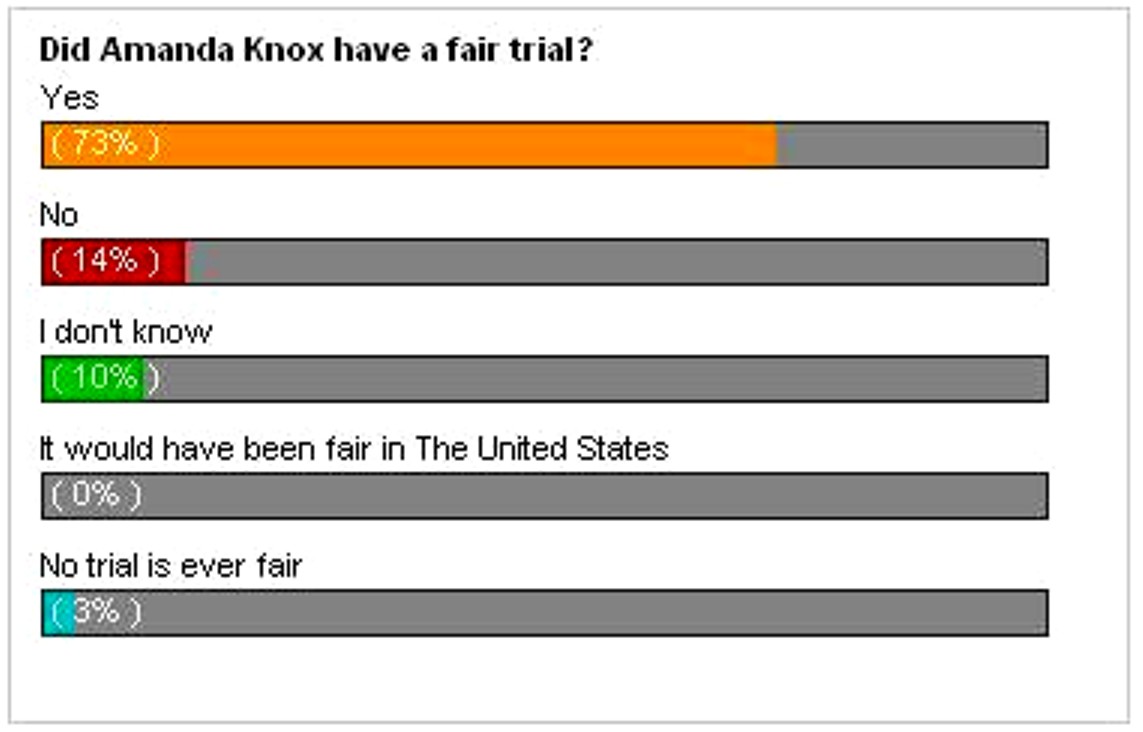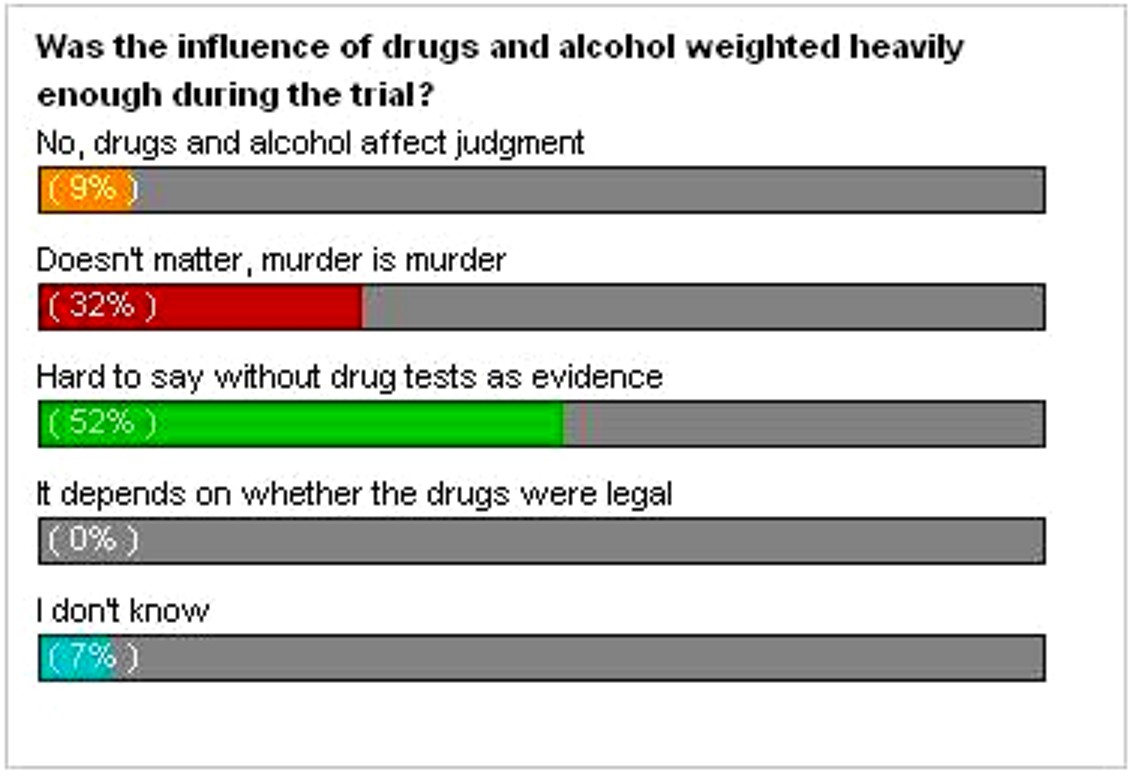
Category: Media developments
Tuesday, November 09, 2010
A Perugian Media Report (Neutral As Usual) In Italian On Knox’s Calunnia Hearing
Posted by Peter Quennell
Shown here is the more modern of Perugia’s courts not far from the questura (central police station) and the railway station. It was here that Judge Micheli tried and sentenced Rudy Guede in October 2008 and sent Sollecito and Knox off for trial.
This court is said to be more suited to closed sessions and to sessions where there is a large press. Indictees and perps enter the court via a ramp down to the basement in vans with darkened windows.
These inside shots of the ground-floor corridor are all we have posted so far on the court’s interior. It was a surprise they allowed a photographed perp walk here, there was none at the previous hearing. Maybe to show AK is okay?
That might be Chris Mellas that she gives a faint grin to, to the left. Perhaps he made sure the camera was there.
Tuesday, May 18, 2010
How Each of The Three Subtly But Surely Pushed The Other Two Closer to The Fire (Part 4 of 4)
Posted by Cesare Beccaria
My previous report appeared here. In January 2009 the trial of Knox and Sollecito sees its first session. In February 2009 the prosecutor calls Rudy Guede to testify in the trial of his presumed accomplices.
A year earlier, Guede had said, on several occasions, that he wanted to have a face-to-face confrontation with Sollecito. This time, on the contrary, he says that he will be “mute” until his appeal, although he could “say some heavy stuff regarding the two defendants, but first I have to defend myself.”
All the attorneys conveniently keep their client off the stand, except for Amanda, who does a fairly decent job. Guede is not put on the stand and no confrontation was allowed by his lawyers. Sollecito is conveniently kept on the sidelines throughout the trial except for a couple of interventions. All their words were filtered by their lawyers.
On 4 April 2009 Guede is again called to testify at the trial in Corte D’Assise, andt he exercises his right to silence. From February to December 2009 the three attorneys play their game in Court, both in the Guede appeal and in the Knox-Sollecito trial in the Corte D’Assise.
Everything they said is documented in the trial transcripts and their reciprocal accusations went on and off until the last days in the Corte D’Assise.
As we have already seen for Rudy’s trial, during the closing statements the explicit accusations re-emerges with great strength (“the only guilty person is Guede, while Raffaele must be acquitted”, says Mrs. Buongiorno) and then the ceasefire kicks right back in again, right after the trial.
In mid-December 2009 a fourth Porta a Porta program discusses the murder of Perugia.
The previous week Amanda Knox and Raffaele Solecito have been found guilty of the murder, and now Guede is waiting for his verdict on appeal.
On this program the attorneys continue with their veiled reciprocal accusations, but without being direct and too explicit. More than a ceasefire, it’s an armed truce.
Amanda Knox’s attorneys were not present on the program, but Amanda was represented by Mrs. Sabina Castelfranco, the correspondent for CBS. This time she timidly tries to venture into the usual American media propaganda and lies regarding this case, but she’s regularly contradicted, and on certain occasions even ridiculed.
Sollecito’s father is present in the studio. His father talks about the innocence of his son, and only of his son, without mentioning anything in defense of Amanda. “My son was not at that house…. Curatolo could not have seen my son because he was at his house”. He says that if Raffaele was present at the crime scene he would have helped Meredith, and so on.
The host Bruno Vespa asks Sollecito’s father why did Amanda accuse Patrick, an innocent man? Francesco Sollecito responds “You are giving me a hard task, that of being not only the defender of my son but also of Amanda Knox”.
Giuseppe Castellini, director of the Perugia newspaper Giornale dell’Umbria, says that this trial has a logic, and such logic emerged from the various judges in 2008 up to Judge Micheli (GUP) that charged them with the crime.
The judges had said that more than one person committed the crime.
“Clear elements prove than more people were involved”. There’s physical evidence at the crime scene of more than one person. Two witnesses heard the screaming and more than one person leaving the house. The GUP had asked “Who are these people?” and Castellini concludes that “all clues and all circumstantial evidence lead to only two people and to no one else”.
“This is the weird thing”, says Castellini. “Everything leads to Amanda and Raffaele. There is not a third person…. Defense then rightly tries to dismantle such pieces of evidence one by one, but this is in essence the story of this trial”.
The host Bruno Vespa asks Guede’s lawyer Biscotti “You claim that the killers are Amanda and Raffaele?” Biscotti responds: “No, actually it is the Court that has decided on first instance that Amanda and Raffaele are the killers”.
The discussion rotates around Rudy’s role and statements.
We know that Rudy Guede never took the stand at either trials and only gave a spontaneous declaration that doesn’t require any questioning on the part of the prosecutor. In court, Rudy said: “I heard the voice of both Meredith and Amanda and they were arguing over what Meredith had already told me: the money that Meredith was missing”.
Rudy says he heard Meredith saying to Amanda “We need to talk”, and Amanda responding: “What’s happening?” In his declarations in Court Guede does not mention Raffaele (as he had previously done out of trial) but merely states that he was assaulted by a young man, in a time span of few seconds, and couldn’t recognize him. (Note that in previous statements he had said that the struggle lasted few minutes and that the assailant was Raffaele).
Vincenzo Mastronardi, a criminologist hired by Guede’s defense, repeats what Rudy told him: “I heard the bell. I heard it was Amanda. I heard Meredith say “˜we need to talk’”. Bruno Vespa asks him: “Did he only hear Amanda?”, and he responds “Yes, he only heard Amanda”.
Then Mastronardi explains his discussion with Guede. He asks him “Did he have glasses? He responded “˜no’. Did he look like Raffaele Sollecito? He responded “˜I don’t know, he might look like him but I am not certain’. “˜All I am certain of, is that the voice was of Amanda’ “.
This is interesting: why does Guede confirm that Amanda was in the house, but does not confirm - in December 2009, just a few days before his verdict on appeal - that Raffaele was also in the house?
Why has he been accusing Raffaele since March 2008 and now, just before his verdict on appeal, he says (or rather, his consultants say) that he’s certain about Amanda but not of Raffaele?
Do Guede’s attorneys fear a wrong move by Sollecito’s attorneys, while being confident about Amanda’s attorneys?
At this point the host Bruno Vespa starts a heated argument with the criminologists, claiming that it is not possible that Guede could have not recognized the assailant. “Come on, you’re a criminologist” says Vespa, “you know that anyone could easily recognize the face of the person that is wielding a knife in front of you…. You have to agree that this is an element of objective fragility” he adds.
Paolo Crepet, a psychiatrist, notes that originally Rudy’s version was kind of different. “Rudy talked to his assailant. He was threatened”.
Rudy’s attorney intervenes “No, you remember wrong”. Bruno Vespa also intervenes and says to Biscotti “Wait, you must admit that there is plenty of incongruence. They didn’t give Guede 30 years for nothing”. Biscotti responds “They sentenced Guede just like they sentenced the other two”.
On the timing of the murder, Bruno Vespa asks if it is true that Guede talked about 9:00-9:30PM.
Here the attorney of Guede gives an inaccurate response that was not picked up by anyone in the studio. He says that Rudy said that the murder happened at a later time. “He didn’t have a watch, therefore he didn’t know the exact time [of the murder], but it was certainly very late”, says Biscotti.
This is incorrect. Guede has said, at the beginning and on a couple of occasions after, that he entered the house with Meredith at 21:00 and that he heard the screaming at 21:20-21:30. So why is his attorney now saying that Guede testified that the murder happened much later? Why did no-one in the studio intervene to contest his statement?
On the forensic tests, Bruno Vespa says that “Non-repetitive testing must be done, by law, with the presence of all parties, otherwise they are not valid”.
The lawyer for Meredith and her family, Maresca, responds “All tests are not disputable, since all attorneys and their consultants were notified on the time and date of these non-repetitive tests”.
And in fact no one from the defenses showed up. By law, if they are notified and don’t appear for the testing, the results are perfectly valid. Defense attorneys chose not to be present, although notified and invited, because that was seemingly part of their defense strategy.
Regardless of the outcome of those non-repetitive tests, it would have been strategically preferable to avoid being present, because if the results were favorable to their client, that would be fine. And if the tests went against their clients, they could always claimed contamination at a later time.
On 4 March 2010 Rudy Guede, following the public release of the Motivazione against Knox and Sollecito, said: “chi sa’ parli” (“those who know must speak”).
On 6 March 2010 Rudy Guede writes a letter to Mediaset following the appearance on the scene of Mario Alessi, a child murderer serving a life sentence, who was claiming Guede divulged that he was alone at the house with another accomplice. Guede ends his letter by saying that the “horrible assassination” of Meredith was done by Amanda and Raffaele.
The court reached their decisions based on testimony and evidence from the night presented at trial. Everything else, including diaries, phone calls from Germany, cartwheels and media gossips, was totally irrelevant to the judges.
Formally, Guede’s accusations of the two accomplices must be dated from March 2008, but we know very well that the reciprocal accusations started on November 2007 and they went on for the entire two trials.
Except for Amanda, the attorneys have strategically avoided their clients from taking the stand and responding to questions, confrontations and cross-examination. Raffaele never spoke one word, except for spontaneous declarations. Guede was kept silent throughout the two trials, despite various promises of “speaking out”.
The prosecutor asked to have Guede on the stand for questioning, but he always exercised his right to silence and, as the Massei Report states on page 389 “The defense of Knox and Sollecito did not give their consent to admitting Guede’s declarations”. This is very indicative of the trial strategy adopted: avoiding their clients to pronouncing one bad word and avoiding putting them face to face with each other.
Now for some conclusions.
There is a lot of “I don’t remember” in this horror story. Rudy doesn’t remember the face of the aggressor, but then slowly, but progressively, his mind begins to function and, at appropriate moments, he remembers his name and that of his friend by the door.
Amanda doesn’t remember if she went to Via della Pergola with Lumumba, nor if Raffaele was with her. She doesn’t remember what she did at Raffaele’s house for the entire evening and night, but then she meets a nun in jail that restores her memory.
Raffaele also has a hard time remembering what happened in those few hours. He doesn’t remember if he was home alone or if Amanda was with him. Then he changes his statement but still doesn’t remember if Amanda left and, if she did, at what time she returned.
Can cannabis give such effects in exactly the time frame in which a young woman is being brutally murdered? Why did only three people out of 84 interviewed have this incredible amnesia?
As the journalist of Corriere della Sera, Fiorenza Sarzanini, said: “the arrests happened when they were saying things like “˜I was there with Patrick but can’t remember if Raffaele was also there’.
And Raffaele saying things like “˜I was at my house all night, but I don’t remember if Amanda was with me the entire time’”.
All three have lied several times, lost their memory but then slowly regained it, and changed their stories in order to fit new information as it became progressively known.
But most importantly they all have accused each other from the very beginning.
Not only the appellate judges of Rudy Guede’s trial but even Judge Micheli in Guede’s trial of first instance said that “The defendants, more or less explicitly, have intended to defend themselves by accusing each others.”
And that Rudy Guede “was there and he knows very well what happened”
“We might think that he remains firm on his unsustainable positions in order to cover up for someone, but on the contrary” says Judge Micheli, “it was from the very beginning that he chose not to involve others, and then he changed his attitude when he understood that other people were abandoning him to his own destiny”.
It should also be considered that the defense of Amanda Knox and of Raffaele Sollecito have called to trial only those witnesses that would testify against Rudy Guede and have requested only that police carry out more investigations on Guede.
Also, the Massei Report states that the defenses of Knox and Sollecito have at the end of it all “explicitly indicated Rudy Guede as the sole perpetrator of the criminal acts against Meredith Kercher”.
Rudy’s original story of the events was so ridiculous that no one could have possibly believed him. And no one did.
Despite this, he avoided naming his presumed accomplices directly, but chose instead, from the very beginning, to imply their involvement through his writings and his threats, while waiting for the appropriate time to formally accuse them of the murder.
“Guede kept quiet for as long as he could” said the Court of Appeal “because, given the deep connection of the events, accusing Amanda and Raffaele would have exposed him to their very probable retaliation”.
The court said all three should have explained what had happened in that house on the night of the murder, “at least for a sense of human compassion toward the poor victim”.
Instead, they “preferred to cram their statements (made on several occasions) with lies, reticence, half-truth, allusions, improbable occurrences and by more or less veiled reciprocal accusations”.
This is my final report. Ciao from Rome, and thanks.
Sunday, May 16, 2010
How Each of The Three Subtly But Surely Pushed The Other Two Closer to The Fire (Part 3 of 4)
Posted by Cesare Beccaria
My previous report on this appeared here.
During the first two months of 2008, the attorneys of Amanda Knox and Raffaele Sollecito begin to elaborate their theory of the sole killer that entered the house through the window, and then raped and killed Meredith.
It is interesting that these attorneys at first didn’t mention the name of Rudy Guede though the accusation was more or less explicit.
During his chat conversations from Germany Guede had already mentioned Raffaele’s involvement. When Giacomo asked him if that was Raffaele he had replied several times “I think so”. But as the two previous posts below show, thereafter he began to pull back.
By the time of his three-hour interrogation with the prosecutor on 26 March 2008 Rudy Guede apparently has had enough, and he is done with pulling back any longer. He now formally accuses Knox and Sollecito (“I saw Amanda and Raffaele that night”).
He now shows no doubts about identifying Raffaele Sollecito as the aggressor (“that guy with the knife was Raffaele”).
When asked by the interrogators why he responded “no” to the question of Giacomo as to whether Amanda “did it”, Guede states first that he was mainly concentrated on the male figure with the knife, and second his response to Giacomo’s questions was given in a hurry.
But Rudy did mention Amanda’s name in those previous conversations from Germany, indirectly implying her involvement. Amanda Knox was also mentioned extensively in his diary written at the end of November 2007, and he described her there in harsh words.
During his interrogation by the prosecutor, Guede now adds that he heard Amanda’s voice by the door, and then he saw her silhouette from Filomena’s window (“As Raffaele walked out I heard someone waiting for him outside. Now I can say that it was Amanda Knox”).
Judge Micheli in his January 2009 sentencing report for the Guede trial points out that Guede constantly “adjusted the content of his statements to the parallel and progressive evolution of the investigations”. He conveniently adjusted the time of the murder and other claimed facts as the investigation proceeded.
Guede originally indicated the time of Meredith’s murder as having been around 9:20-9:30PM. This is what he told Giacomo during the Skype conversation. His attorneys would later push the time to 11:30PM, denying that Guede had ever talked about 9:30 and couldn’t have known the time anyway as he hadn’t had a watch on him.
The Micheli Report states that Guede’s accusation of Amanda and Raffaele formally happened during the interrogation of 26 March 2008. The conversations from Germany were not admitted by the court, and nor was his diary. Only Giacomo’s testimony was considered.
Judge Micheli in his sentencing report considers none of Guede’s declarations as credible.
On December 7in his first interrogation on his arrival back in Italy, Rudy never made references to Amanda. He said that he looked out the window but didn’t see or recognized anyone.
Judge Micheli therefore says that the interrogation of March 26, 2008 cannot be considered a completion of his previous declaration (as his lawyers were asserting), but rather a “radical change of course”.
Why didn’t Guede accuse Amanda and Raffaele during, or right after, the interrogation of December 7?
After all, he had a great opportunity to claim to recognize a person that was arrested and accused of the murder whose name was well known to Rudy. And as Micheli states in the report, “Guede didn’t even have the natural qualms that a witness might have in cases of uncertainty, knowing that he might get an innocent person in trouble”.
So why did he reserve the right to indicate his alleged accomplices at a later time?
On 15 May 2008 Guede asks to make some new spontaneous declarations.
Among other claims, he claims to have seen Raffaele at the scene of the crime, and his new conviction about this derives from the fact that he had seen his pictures in the newspapers. He also confirms the presence of Amanda: “I heard various steps of people leaving. I went to the closest room, I looked outside and I saw the silhouette of Amanda”.
On 19 October 2008 the prosecutor at Guede’s trial in his closing statement observes that “at the beginning Amanda had intentionally covered up for Guede, sidetracking the investigators toward another black person. For his part, Rudy has tried to keep Amanda out while being more explicit in involving Raffaele”.
On 24 October 2008 Francesco Vinci, the forensic consultant for the Sollecito defense, hands over to the Court his analysis report for the DNA on Meredith’s bra hook (Evidence 165B).
He states that “the analysis clearly shows that there are profiles of three other individuals on the clasp”, adding that the genetic profiles of Amanda and Rudy are also on the clasp.
Although Vinci’s presumed intention is to try to remove from trial the evidence against his client (since too many DNA profiles are found on the clasp, making it hard to reach an “unequivocal interpretation”) in reality this intervention comes across like an attempt to involve Guede’ s other two unlucky friends.
Meo Ponte, correspondent of La Repubblica, puts it nicely: “One asks if this is an involuntary false step or if Sollecito’s defense has decided to return to their previous steps when, at the beginning of the investigations, they were looking at every possible way to separate the fate of Raffaele from that of Amanda, trying to reduce charges against Raffaele to those of a lesser crime”.
Interesting here is that four days before the verdict of the first instance against Rudy Guede (and the decision on the formal charging of Knox and Sollecito) all the attorneys for all three can be seen to be fighting a three-way war, trying to save their own clients at the expense of the others.
Mr Mignini couldn’t have asked for more. This tactic almost renders superfluous the presence and arguments of the prosecutor.
Knox’s and Sollecito’s attorneys are indirectly accusing Guede (without mentioning his name) by trying to prove the sole-killer theory. And Guede’s attorneys are definitely implicating Knox and Sollecito, and at the last day of trial explicitly accuse them of the murder.
On 28 October 2008 Rudy Guede receives a 30 years sentence, and Amanda Knox and Raffaele Sollecito are formally also charged for Meredith’s murder.
The day after on 29 October 2008 the top-rated national TV program Porta a Porta (in the second of the four shows so far) discusses the trial outcome of the previous day. All the lawyers are present except for those of Amanda Knox.
Whereas during the days before the trial all the attorneys were fighting for their own client, and accusing each other’s clients of murder, during this Porta a Porta program they look fairly friendly.
Mrs. Buongiorno (the lead lawyer for Raffaele Sollecito) says that she is not saying that it was Guede who killed Meredith, she is saying that “procedural elements” conclude that there is such responsibility. “All I want to say is that Raffaele was not in that house.”
Bruno Vespa, the host of the Porta a Porta program, asks Mr. Biscotti (Rudy Guede’s attorney) if his defense claims that Amanda and Raffaele are the two people identified by Guede on the night of the murder. Biscotti replies that Guede “heard two people”, but he doesn’t confirm that it was Raffaele and Amanda.
Why does Guede’s defense all of a sudden avoid mentioning the names of those whom until the previous day they had accused of the murder?
The magistrate on the show, Simonetta Matone, intervenes and she says: “As part of your defense strategy I remember that you have said that Amanda and Raffaele are the two people responsible for this homicide”.
The attorneys of Guede responded: “well, this is a trial dialectic (dialettica processuale)”. The magistrate then asks them “what are you talking about, trial dialectic? You have claimed that Amanda and Sollecito committed the crime”.
Mr. Biscotti (Guede’s attorney) doesn’t respond, and Mrs. Buongiorno (Sollecito’s attorney) steps in and immediately changes the subject.
Further on in the program, Mr. Biscotti says that Rudy heard Amanda’s voice, but doesn’t say that Guede identified Raffaele.
The Porta a Porta host, Bruno Vespa, asks Biscotti how could it be that Rudy was not able to see the assailant? Biscotti explains that it was dark and the assault was quick.
Bruno Vespa continues to be incredulous and insists that it is impossible for him not to have recognized his attacker.
Why does Biscotti now hide the fact that Guede saw Sollecito, when up to just a few days before he was confirming his identity? In fact, why would both Guede’s attorneys and Sollecito’s attorneys avoid discussing the reciprocal accusations that had gone on for months until just a few days earlier?
Could it be that they are both now preparing for the next trial at the Corte d’Assise, both of them hoping for an acquittal that would be beneficial both to Raffaele and to Rudy?
Right after the first verdict the ceasefire is back in place, and everyone is back out of the gray area.
It’s also interesting that during the program Mrs. Buongiorno insists in defending only Raffaele. She contests the bra clasp but never says anything about the knife. Her only concern is Raffaele.
She says “My trial is as follows: you must prove that three people committed the crime, or you must prove the presence of Raffaele in the house”.
At a certain point in the Porta a Porta program, Alessandro Meluzzi, a well known psychiatrist hired by the Guede team, intervenes during a discussion and says: “”¦ but wasn’t there a footprint found of Raffaele?”.
Mr. Biscotti - Guede’s lawyer - blocks him immediately and says “no, no, no”. Mr Meluzzi looks around in despair and then realizes he has said something outside of the defense line and now keeps quiet instantly. Why was he stopped?
In the first session of the Knox-Sollecito trial in the Corte D’Assise of 16 January 2009 Luca Maori, Sollecito’s second attorney, begins by saying that “Raffaele’s life was destroyed on October 25, the day he met Amanda “¦ this changed his life because of the tragic consequences and at the end [meeting her] has destroyed him”.
In the opening statement Mr. Maori makes it clear and simple: “Justice is already done. Rudy Guede, the only person responsible for the murder, has received a 30 years sentence”.
Asked by journalists about his reaction to these accusations, Walter Biscotti responded as he had done on other occasions: “My client will speak at the appropriate time.”
On 19 January 2009 they are all back again, on the third Porta a Porta show, except (again) for Amanda Knox’s lawyers.
Guede had been sentenced in the first instance to 30 years. His lawyer Biscotti now adds a little more detail to Guede’s story. He explains that Rudy went to the bathroom and heard Amanda discussing with Meredith, put on his earphones and closed the door.
The TV host Bruno Vespa reminds Mr. Biscotti that the attorneys of Sollecito and Amanda have accused Guede, and have said that he was already convicted and therefore he must be the sole killer.
Mr. Biscotti doesn’t appear very happy: “In our opinion this has been a “cowardly procedural move (“vigliaccata processuale”).... They took advantage of the absence of Rudy in that hearing” of 16 January, he replies.
And then he adds that their strategy would not work since the GUP has denied their clients’ release on house arrest and has issued a definite ruling on the matter.
Guede’s attorney is practically saying here that, even though Rudy was convicted in the first instance, the other two are also charged and will also have to stand trial. “We will be vigilant and we’ll observe every breath of that trial”.
(It’s funny how Biscotti refers to his accusation of the other two a few months earlier as “dialettica processuale” (dialectical) but now calls Maori’s accusation of Guede a “vigliaccata processuale” (cowardly).)
The prosecutors have announced that they will call Rudy Guede to testify at the trial of his presumed accomplices, and the Porta a Porta host Bruno Vespa asks Biscotti if Rudy will finally tell the complete truth in front of the Court of Assise.
Biscotti responds that Rudy has already told the truth and that he will next talk further in front of the judges of appeal, implying that his client will not testify at Knox’s and Sollecito’s trial.
He says that since Judge Micheli didn’t find him credible, just like as he didn’t find the other two credible (they were not even called as witnesses at Rudy’s trial), Guede could exercise his right to silence at Knox’s and Sollecito’s trial.
Giuseppe Castellini, director of the Perugia-based newspaper Giornale dell’Umbria, weighs in at length on this Porta a Porta show about Guede’s changing of his versions.
In the second version, Guede says that as he entered the bathroom he heard the bell ring and heard Amanda’s voice. He then was reassured because he knew it was Amanda. Guede also said in his second version that from Filomena’s room he sees Amanda and another person that he couldn’t identify, running away.
In the third version, Rudy hears the voice of Amanda (“We need to talk. What is the matter?”) and he asks Mignini to have a confrontation with Sollecito.
Mr Biscotti, Guede’s attorney, disputes Mr Castellini’s claim that the description changed and he says that Guede never changed his version, but rather “integrated it with details” and that Guede asked for a confrontation with both Raffaele and Amanda.
Mr. Gentile, the other lawyer for Guede, adds that Guede was interrogated in Germany without attorneys present (implying that what he said back then cannot be considered as a first version).
The Porta a Porta host. Bruno Vespa. notes that every one of the three accused is claiming their innocence and at the same time each accusing the other of the murder.
He then asks Luca Maori, one of Sollecito’s attorneys, if the situation of Raffaele is linked to that of Amanda or if there could be a different scenario (“she was there and he wasn’t”).
Mr. Maori responds that “Raffaele is Raffaele and Amanda is Amanda, although this does not mean that their positions could not be linked…. Raffaele was at his house and probably even Amanda, so both were at his house during the night”.
He adds that Raffaele never changed his version.
The newspaper director Giuseppe Castellini reacts strongly to this claim by Mr Maori. He illustrates by reading Raffaele’s statements word by word that he did in fact change his version, three times.
On the first version, of November 5 (which is actually the second version if we exclude the statement in which he said he spoke “a lot of rubbish”) Raffaele said he went home alone, while Amanda went to meet her friends. He says he surfed the web all evening and Amanda returned at 1:00AM.
Days later, police hear from Jovana Popovic, who testified that she rang the bell at 8:40PM and Amanda answered the door, and therefore Amanda must have been home at that time.
Mr Castellini observes that now Raffaele changes his version again and notes how he had said “on November 5 I lied because I was under a lot of pressure”. Mr Castellini says that Raffaele had stated that Amanda was with him all that night, but now, in his latest version, he doesn’t remember if she went out that evening and for how long.
Bruno Vespa asks how can it be possible that a person cannot remember, after just a couple of days, if his girlfriend was with him or not, what time she left, and what time she returned?
“Everyone is able to remember where they were when the man landed on the moon. And that was forty years ago…. Raffaele should have been able to describe minute by minute what happened on that evening”.
The answer of Sollecito’s attorney Mr. Maori is as follow: “Someone must have killed poor Meredith. This someone is certainly not Raffaele Sollecito, because there are no evidences that put him inside the house of the murder. Everything else is details”.
It’s interesting to note that Mr. Maori hardly mentions Amanda Knox.
Even when asked if Amanda was with Raffaele he doesn’t give a straightforward answer, he just repeats that his client is not guilty. Throughout the two hours of the Porta a Porta program, he keeps saying that his client was not at the crime scene: “We will prove in court that he wasn’t there, and that he did not commit the crime.”
The CBS correspondent on the TV show, Mrs. Castelfranco, keeps trying to insert Amanda into the discussion (“Amanda wasn’t there either”) but Maori was not confirming this, he was not even listening.
The host Bruno Vespa tells Maori that there was more than one person reported by a witness as leaving the house and therefore “the killers must have been more than one”.
Mr. Maori’s answer is: “We are not alone in saying that the killer is only one. It’s the judge that has sentenced just one person”.
Guede’s attorney replies: “Oh, come on, Maori ! How can you say these things?.
A very important issue is now brought up by the host, Bruno Vespa.
Talking about Amanda, he says that it’s very strange that a person says “I was there” and then days later denies being there.
“Usually people say “˜I was not there, I know nothing, I have seen nothing’ and then eventually they admit that they were there”, says Vespa. “Instead Amanda [at first] says “˜I was there’ and the killer is Lumumba”.
No one in the Porta a Porta studio contests Mr Vespa’s claim that this is strange, including Maori and the CBS correspondent.
And the reason is very simple: while the U.S. media has justified Amanda’s behavior by claiming that she was forced to name Lumumba under brutal police pressure, the Italian media has never reported this because there is zero evidence that it ever happened.
The widely known and believed fact is that Amanda named Lumumba voluntarily, when the police asked her to verify her cell phone activities and was asked who that person was. This is a given and indisputable fact, confirmed by various witnesses.
Even Mrs. Castelfranco, the CBS correspondent, is very careful in not repeating the false claim of the U.S. media. She says instead that Knox was “young and confused”. The CBS correspondent adds that after all none of them remember well what happened that night.
The host Bruno Vespa interrupts her: “One thing is remembering single details. Another is remembering if she was there or not. Being at the house [of the crime] or sleeping at the house of the boyfriend, are two enormously different things…. It is very striking that her first instinct was that of saying “˜I was at the house of the crime’”.
The CBS correspondent remains silent.
At this point, Mr. Biscotti, Guede’s attorney, says that while Rudy admits to being in the house, the other two each deny their presence although there is evidence that unequivocally confirms both of their presences.
Mr Vespa asks Biscotti if their trial strategy is that of proving Rudy’s innocence, or if it would be convenient to them to also demonstrate the culpability of Amanda and Raffaele.
Guede’s lawyer Biscotti responds: “We don’t want to prove their guiltiness. But since there is no other individual whose evidence in the house is proved, we must make a logical inference”.
The host reminds Biscotti that they have explicitly accused Raffaele and Amanda during Guede’s trial. Biscotti responds: “Well, the logical inference tells us that Amanda and Sollecito are the guilty ones”.
Mr Vespa asks “Therefore the person that ran into Rudy (whom he did not fully identify) would be Sollecito?”.
And Biscotti responds “In our opinion, since we were not there and could not have seen it, by linking all the circumstances that emerged from the investigation of the prosecutor and those that emerged from the preliminary hearing, this leads to the conclusion that whoever killed Meredith could not have been other than the other two defendants”.
Francesco Maresca, the attorney for the Kercher family, makes it plain that in his view all three defendants are without any doubt responsible for Meredith’s murder.
My next report appears here.
Friday, May 14, 2010
How Each of The Three Subtly But Surely Pushed The Other Two Closer to The Fire (Part 2 of 4)
Posted by Cesare Beccaria
My previous report on this appeared here. On 12 November 2007 Guede has a first chat conversation on MS Messenger, from Germany, with his friend Gabriele.
His friend asked him why he keeps running away, and Guede answers “I can’t”. “You can’t what?” asks his friend. Guede replied “you know [why]”. “What should I know” asks his friend, but with no further reply.
Up to that moment the media knew nothing about Rudy Guede’s involvement, but he certainly felt that police were already investigating him. He knew that thus far Amanda and Raffaele had not mentioned his name.
On 15 November the investigators identify the finger print on the pillow as belonging to Rudy Guede.
On 16 November Giacomo, another friend of Rudy, was informed that Guede could have had something to do with the murder, and on the 18th he is interrogated by the prosecutor.
On 18 November Raffaele writes in his diary: “As I am thinking and rebuilding [my thoughts] I think that Amanda always remained with me. The only thing I don’t remember exactly is if she left during the evening for few minutes”.
At this point police know that Raffaele and Amanda were together at his house when Jovana Popovic arrived at 8:40PM. But they were also found together at Raffaele’s house when Jovana rang the bell in the afternoon between 5:45-6:00PM.
Why then would Raffaele say at first that he went home alone at 9:00PM, and then that “maybe it was 8:30” and Amanda was with him, and now he thinks that Amanda was with him the entire time, but he doesn’t remember if she left and, in the event that she did, at what time she returned?
Was he desperately attempting to dissociate himself from Amanda? Was he then being told to retract, but just not too much?
“I am certain that she cannot have killed Meredith and then returned home” says Raffaele. “I hope that truth emerges. None of us three [meaning also Patrick Lumumba] have anything to do with this”.
Here again we find this supposition regarding Amanda. A week before he said “It would be fabulous if Amanda hasn’t done anything” and the previous day he said: “I don’t think she’s capable of killing someone”.
What is the need of all these quasi affirmations? And why does Amanda make the exact same quasi affirmations in her own diaries?
On 19 November Guede has another chat conversation on MS Messenger, this time with Giacomo. He explains to Giacomo what had happened that evening, and that neither Amanda nor Patrick are involved.
Why does he explicitly deny Amanda’s involvement in the murder? Could he be covering up for her, since she also hasn’t ever mentioned his name up to this date?
On the same chat session, Rudy describes the aggressor as an Italian of young age. When Giacomo asks if that person was Raffaele, his reply was “I don’t know, but I think so”. He repeated “I think so” several times as Giacomo kept asking him if he was sure that person was Raffaele.
Soon after, Giacomo and Rudy started a conversation via Skype, the online video phone system. This conversation was recorded, and made public.
A couple of parts are very important. First of all, Rudy puts a lot of emphasis on the money stolen, and on Meredith being upset with Amanda. Why would he be so insisting on this matter?
Rudy adds that “Amanda never mentioned the money issue, nor did Raffaele” implying that he somehow knows this information first-hand, since it had not ever been reported in the media up to that day.
Rudy then tells Giacomo that he went to the bathroom, and heard the doorbell ring and Meredith opening the front door. Rudy adds that “It could have been anyone “¦ it could have been Amanda”.
So again he explicitly mentions Amanda. Why would he say “It could have been Amanda”?
On that same conversation Guede reads a paragraph to Giacomo from a media article mentioning the laundry, the break-in and the undressing of the victim, Meredith.
Guede says “If all this really happened, it must have been done by Amanda or Raffaele… they have done it”. Giacomo asks “Why would they have done this”? And Guede replies “Because when I left she [Meredith] was dressed”.
Giacomo says “So they killed her while she was dressed”. And Guede says: “Yes, here it says that they [clothes] were washed in the washing machine, but that’s not true. She was dressed”. And then he explains to Giacomo how she was dressed and adds: “That means that they have washed them [Meredith’s clothes]”.
Then Giacomo asks “But why did they wash her clothes if she [Amanda] has nothing to do with this”, and Guede replies “What the hell do I know”. And finally Guede adds: ” “¦ then after, from what I read, someone came back, because when I left the window was not broken. That means that someone broke it, and it wasn’t me”.
Again, here we have Rudy Guede mentioning Amanda and Raffaele. Why would he mention their names, and assume that they staged the break-in, undressed the victim, and did some laundry?
On 20 November Raffaele writes “Today they finally caught the real killer of this incredible story. They found him in Germany. But at the moment I am not 100% tranquil because I fear that he might make up strange things”.
Why would Raffaele fear that the killer might fabricate some strange things?
On 20 November Rudy is arrested in Germany. He is interrogated for the first time, in Koblenz, where he repeats the same version he had given to Giacomo on the phone, except that he does not mention Amanda or Raffaele.
During his detention he writes a memorandum in which he describes the events of the night of the murder.
This document is of extreme importance, since this time he does mention Amanda again, this time with serious threats.
First, he includes “kind words” for Meredith
To see these written in a memorandum while denying his own role in her death and failure to save her seem simply repulsive. They seem about the lowest thing that a man with a minimum of decency could ever write.
He was undeniably there when she was killed, and according to the judges he participated to the murder. His story of using an I-Pod when going to the bathroom and not hearing things and then hearing things seem simple stupidity.
Second, Guede indicates that Amanda’s story of being at the house with Patrick is not true.
He knows that Patrick has been recently released. Why then does he ask “How could Amanda have slept in that place full of blood”? Also, why is he blaming Amanda for not calling the ambulance?
Also, Rudy knew that Amanda stated that she heard Meredith screaming. Why would he tell Giacomo on Skype that he heard “a scream so loud that it could have been heard from the street”?
Third, in his writings, Rudy asks Amanda for the reason for her account of Meredith being raped. “Meredith and I just talked that night” Rudy writes. Then he adds “Say the truth, what are you hiding”.
We see here another important statement that Guede is making. Why would he be upset that Amanda said that Meredith was raped? Also, why would he want to clarify the fact that with Meredith they “just talked”?
Guede sounds as if he’s extremely upset about Amanda’s story of rape, and about the accusation of a black man. To him all this must appear as if Amanda was giving clues to the prosecutor to look further into Guede as the possibly killer.
We should note that Amanda did make a partial retraction when she states that her story could have been an imagination of her mind. But she never fully retracted her story, or her accusation against a black man.
Guede knows that Amanda’s story is not just partially but totally untrue. For this reason he writes a harsh criticism of Amanda and asks her, in a threatening way, to talk and speak the truth.
Guede is also angry about what he read regarding the staged break-in, the undressing of the victim, and the laundry, and quite probably about the evidence left intact in the toilet.
To him, the sum of these events and statements by Amanda probably looked like a direct attempt now to accuse him of the murder. “You already knew who to blame” he asks.
And then in turn he blames Amanda for the killing. “Did you hate your friend so much to the point of killing her or wishing her death?”.
All this was written as early-on as 20 November 2007.
Raffaele is also mentioned by Guede in his prison diary. He writes: “that AF, AF, could have been his name?”. Rudy adds: “what the hell happened that night. Talk and say the truth. What are you hiding. If it wasn’t Raffaele with you that night, who was it?”.
So we can clearly see that the reciprocal accusations began long before March 2008. Much less than one month after the murder of Meredith, they were already threatening one another and accusing each other.
And there’s more.
On 23 November 2007 three days after Guede is arrested in Germany, Raffaele requests an appointment with the prosecutor because he wants to clarify his position.
Mignini sets the appointment for 6 December 2007.
On 3 December 2007 Walter Biscotti, Guede’s attorney, announces on the Porta a Porta show (the most popular television program in Italy) that his client has important revelations to make, and that he “saw the killer and might be able to identify him “¦ Rudy didn’t tell me his name “¦ on his return I will show him the pictures and I imagine that he will be able to recognize him”.
But hadn’t Rudy already seen Raffaele’s pictures on the media while in Germany? Didn’t Giacomo ask him if it was Raffaele, to which he responded “I don’t know but I think so”?
On 5 December 2007 Guede meets his father in Mannheim.
According to “Il Messaggero” and “Il Mattino”, Rudy is quoted as saying: “I want to return to Italy as soon as possible and tell everything I know. I want to indicate the murderer of Meredith. I saw him and I could recognize him. Someone else was with him”.
When journalists ask Rudy’s attorney if he has seen the photos of Raffaele, he responds that all this is a matter for the prosecutor.
On 6 December 2007 Raffaele is questioned by Mr. Mignini - but he exercises his right to remain silent! Although it was he that asked to be interrogated in order to “clarify his position”.
On 7 December 2007 Guede arrives in Italy and is interrogated by the prosecutor.
Everyone is expecting Rudy to announce the name of Raffaele, but he doesn’t. He never even mentions Amanda. Rudy’s attorney tells the journalists that his client “did not give out the name of the killer because there is no name to give”.
So why did Guede announced from Germany some “important revelations” and that he saw the killer and could identify him - and then he doesn’t?
Why did Raffaele ask to be interrogated and then, after Rudy’s threat, and the day before Guede’s arrival, he exercises the right to remain silent once he sits down, face to face, at his own request, with the prosecutor?
Walter Biscotti tells the prosecutor that any “possible procedural action of recognition will be subject to subsequent interrogation” (“eventuali attivita’ processuali di riconoscimento saranno oggetto di successivo interrogatorio”).
Does this mean that Rudy is reserving the right to indicate the killer sometime in the future?
During the trial, Mr. Biscotti specifically noted that the name of Amanda Knox was not brought up by Guede only late in the day, since during the interrogation of 7 December 2007 by the GIP (the judge for the preliminary hearings) the attorney had stated that his client would be “available to provide further clarifications” right then.
Only the working schedule of the prosecutor made the interrogation slide to March 2008.
On 7 December 2007 Rudy Guede was interrogated by the GIP for seven hours, and he claimed his innocence. He explains his byzantine version of the events on the night, and he never mentions Amanda or Raffaele.
Guede says “I don’t know who the killer is and I cannot give a precise description because I was concentrating on looking at the knife”. Guede says that he heard two people talking outside the house, but he couldn’t even tell if those voices were of a male or a female.
In response to many other questions, his recurrent phrase was “I don’t remember”. He also explained his knowledge of Meredith’s missing money, which Rudy knew way before it became of public knowledge as he revealed in the conversation with Giacomo from Germany.
Amanda had previously said she had been at the house on the night of the murder, and she had never mentioned the name of Rudy, accusing instead another black man.
On 14 December 2007 Guede is heard by the Tribunale del Riesame.
He repeats that he didn’t see the aggressor because it was dark but that he could create an identikit. He confirms that two people were present, but doesn’t name Amanda or Raffaele.
The judge warns him that he must reveal the truth by telling the names of the people involved, but he refuses, saying that he never met Raffaele, and that he didn’t know Amanda had a boyfriend.
The Tribunale rejected his plea of house arrests because he was not coming clean.
A few days after his return to Italy, Guede receives a visit in prison from his friend Giacomo. During the conversation, Guede tells him that his memory was improving and that he saw Amanda at the house.
We can again see therefore that Amanda is mentioned, way before March 2008.
Guede also adds that Amanda accused Lumumba because, most likely, the assailant told her that a black man was in the house. Guede tells Giacomo that he had never met Sollecito before.
This discussion in prison took place on 7 December 2007 though it was brought out at trial only much later, through Giacomo’s testimony.
On 25 January 2008 Sollecito’s attorneys allow him or make him to say “I don’t know Rudy Guede but I am ready for a face to face confrontation with him”.
Obviously it was just a bluff.
Raffaele never talked, was never cross-examined, and was always kept off the stand. All we know about his statements was either through his lawyers or his father.
My next report appears here.
Wednesday, May 12, 2010
How Each of The Three Subtly But Surely Pushed The Other Two Closer to The Fire (Part 1 of 4)
Posted by Cesare Beccaria
Most people in Italy believe the two trials ended correctly because they have been exhaustively reported-to throughout.
Also they have been able to follow the machinations and the twists and turns of the three defendants and defenses in real time. And the court documents and transcripts are all issued in Italian, and some are officially posted on the Internet.
The media coverage in Italian in Italy exceeds the media coverage in English in the UK and USA by a factor of five or ten. And there have been a number of very highly rated and balanced TV talk-shows on the case, in the course of which the defenses were not able to muzzle or slant the discussions - even if they ever considered doing such a thing.
These TV talk-shows on the case have included the most prestigious of all such shows in Italy, Porta a Porta, which offered hours of discussion by all the legal players except for Amanda Knox’s team in December 2007, October 2008, February 2009, and December 2009.
The Porta a Porta discussions are at various points referred to here, and the images used here are from those shows.
This is a four-part analysis, based mostly on Italian-language sources, of the many twists and turns of each of the defendants (as they then were) and their defense teams when intent on giving themselves an edge while often slyly selling out the others.
This interplay has been evident almost as much between Knox and Sollecito and their teams as it has between either of them and Rudy Guede, though rather less hostile.
It is worth pointing out two things up-front. First, that this is still far from played-out, more twists and turns can be expected, and we still might see the complete flying-apart and separation of all three. And second, that public maneuvering like this by three people accused of a crime is REALLY unusual and there have been few real precedents. This behavior sure is not typical of innocent parties.
So to begin…
“Guede has kept quiet for as long as he could” said the Court of Appeal in its recent motivation report “because, given the deep connection of the events, accusing Amanda and Raffaele would have exposed him to their very probable retaliation”. (“Guede, finché ha potuto, ha taciuto, poiché, stante la profonda connessione degli eventi, accusare Amanda e Raffaele lo avrebbe esposto a più che probabili dichiarazioni ritorsive da parte di costoro”).
This phrase in boldface is extremely important in understanding the connection of the three actors to this horrible story.
Their attorneys have done an excellent job so far (the best they could) and will continue on appeal to try to convince the judges of their innocence, or at least for a substantial reduction of their sentence. Rudy Guede’s attorneys have already obtained what they needed. He will probably be out on parole in less than five years now.
The other defense have played a very delicate game in this trial. From the beginning, they could have asked for a finding of “preterintenzione” (a sort of non-intentional second-degree murder). But this would have forced their clients to admit the truth without the certainty of the judicial outcome. Hence they opted for the not-guilty plea.
Their first strategic action was in each case (RS and AK) to stop the damages that their clients were inflicting upon themselves with their statements.
The next strategic action was that of not appearing at the lab for the non-repetitive testing for the DNA, with the obvious intention (almost habitual in Italy) of refuting ex-post each and every forensic finding that could have been adverse to their client.
The third strategic action flowed from the major problem all the attorneys were facing in defending their own client: the risk of reciprocal retaliation. Like concentric circles, they all came to share a gray area that was tacitly considered off-limit for everyone else, like a haunted house that no one else dared to enter.
At first, this tacit accord was respected. But when various defense necessities emerged, the breaching of the accord began. The process was gradual but inexorable, leading to two brief but clear breaches: Guede’s explicit accusations against the other two in March 2008, and reiterated right after the disgraceful intrusion on the scene of Mario Alessi earlier this year.
This tactic was observed by the Appellate Court that heard Guede’s appeal. In their recent motivation report.
The judges reprehended all three offenders by stating that all three should have explained what had happened in that house on the night of the murder, “at least for a sense of human compassion toward the poor victim” and that instead they had “preferred to cram their statements (made on several occasions) with lies, reticence, half-truth, allusions, improbable occurrences and by more or less veiled reciprocal accusations”. (“Gli imputati hanno invece preferito infarcire le loro dichiarazioni, rese in diverse occasioni, di bugie, reticenze, retromarce, mezze verità , allusioni, prospettazioni inverosimili, accuse reciproche, più o meno velate”).
Rudy Guede was questioned in Koblenz, Germany, right after his arrest. He was also interrogated on December 7, 2007 and on March 26, 2008, and made spontaneous declarations on May 15, 2008.
At first he did not formally accuse anyone, and he remained very vague about his accomplices. He chose to go on trial first and so he had a slight advantage over the others.
Rudy Guede is undoubtedly a compulsive liar. He told his version of the events to perfectly fit his case, and adjusted his inconsistencies according to the changing development of events.
He first says Meredith was killed around 21:20 and then his attorneys made him change the time to 23:30. According to his absolutely improbable account, he met with Meredith at 21:00 and within TEN MINUTES they managed to talk about her mother’s health, go around the house looking for the missing money, had oral sex, and then suddenly had an urgent need to go to the bathroom. Then he puts his I-Pod on at high volume while doing his business in the bathroom of a girl he barely knew.
In this implausible story, Guede doesn’t explicitly name his accomplices. Amanda and Raffaele also told their fair share of lies, but at the beginning they didn’t directly accuse Guede either.
Things changed when the various attorneys started to slowly penetrate inside the off-limit zone.
Guede’s memory began to function as the lone-wolf theory was materializing. Apparently the volume of his I-Pod was not loud enough now to impede him from recognizing Amanda’s voice. His vision became clearer and he began to recognize her silhouette from the window and the identity of the aggressor.
The more Knox and Sollecito’s attorneys were elaborating their theory to reinforce their defensive strategy, the better Guede’s memory became. Every time allegations of the sole killer emerged, Guede’s attorneys were ready with their rounds of ammunitions, needed to keep the other attorneys at bay.
Now, if we take a closer look at the chronology of events, we can observe a possibility that has been largely overlooked but is of extreme importance.
Maybe the staged break-in was not necessarily made with the intention specifically to frame Guede. (Judge Micheli actually advanced this notion, as Amanda and Raffaele most likely had no knowledge of Guede’s earlier break-in in Milan.).
And yet it is without doubt that some one person or several persons intentionally tried to mislead investigators and with a good degree of certainty these people took also part in the crime. And for obvious reasons Guede was not among them during the staging and the cleaning.
Let us now look more closely at the chronology of the events in order to understand why it is clear that Guede did not act alone. Also to see that he did mention Amanda and Raffaele way before the interrogation of March 2008. We can also observe how the three defendants have tried in various ways to accuse each other from the very beginning, through their voluntary statements and through their “prison diaries”.
It should be noted that it is highly unrealistic that lawyers let their clients write “prison diaries” without their consent, especially after all the lies and inconsistencies they have told to police and prosecutors until they took over. Those “prison diaries” sound anything but spontaneous.
Raffaele changed his versions of the events at least three times. At first he confirms Amanda’s original deposition. But then, under interrogation on 5 November he admits to having spoken rubbish in his previous statement, because, he claimed, Amanda convinced him of her version and he didn’t think of the inconsistencies. And that he went home alone around 9:00 PM, smoked a joint, ate and surfed the net, and finally Amanda returned at 1:00 AM.
Amanda then is told by police that Raffaele had just blown her alibi. But instead of refuting Raffaele’s statement, she immediately takes the opportunity to accuse Patrick Lumumba, adding that Raffaele was probably with her at the crime scene.
Let’s now look at Amanda’s statement given to police on 6 November 2007.
Amanda writes: “I know that Raffaele has placed evidence against me, saying I was not with him on the night of the murder “¦ there are things I remember and things that are confused “¦ what happened after I know does not match with what Raffaele was saying”. Amanda goes on to explain what happened at Raffaele’s house in a very confusing way and with many “perhaps”, I’m not sure” and “I don’t remember”.
She goes on to write: “my boyfriend has claimed that I have said things that I know are not true “¦ I never asked him to lie for me “¦ What I don’t understand is why Raffaele would lie about this. What does he have to hide? I don’t think he killed Meredith but I do think he is scared, like me. He walked into a situation that he has never had to be in, and perhaps he is trying to find a way out by disassociating himself with me”.
She adds: “I also know that the fact that I can’t fully recall the events that I claim took place at Raffaele’s home during the time Meredith was murdered in incriminating”. Raffaele as well states that he cannot recall precisely what he did at his own house that evening.
Amanda remembers that she noticed blood on Raffaele’s hand, “but I was under the impression that it was blood from the fish”. Amanda then asks: “is there any other evidence condemning Patrick or any other person. Who is the real murderer?”
A week later, when the knife was found, Amanda goes even further. She now wonders if Raffaele could have killed Meredith and then put the knife-handle in her hand while she was sleeping. “Was Meredith’s DNA on the knife?” Raffaele had asked “Maybe, because one time I accidently pricked her”.
“It’s impossible that Meredith’s DNA is on the knife”, says Amanda, “because she’s never been to Raffaele’s apartment. So unless Raffaele decided to get up after I fell asleep, grabbed said knife, went over to my house, used it to kill Meredith, came home, cleaned the blood off, rubbed my fingerprints all over it, put it away, tucked himself back into bed, and then pretended really well over the next few days, well, I just highly doubt all of that”.
Doesn’t all this sound like a reciprocal veiled accusation? Why would two people accused of murder, with exactly the same fate, write down their doubts about the innocence of their presumed accomplice? Why doesn’t Amanda mention Patrick or Rudy at all in her diary?
On 7 November 2007 Raffaele Sollecito begins writing his own diary. His most recurrent phrases are “I don’t remember”, “maybe I did this, maybe I did that”. The prosecutor has already reminded him that he has given three different versions of his story, in particular about Amanda. He is still not sure if Amanda left the house, and if she did he now doesn’t remember how long she was out for. “Why don’t they investigate on her”, he asks.
On 11 November 2007 Raffaele recalls that someone told him that on the morning of November 2 Amanda went home to take a shower and then went to a public laundry with some Argentinean guy and he put a pair of blue Nikes in the washing machine.
“All this makes me totally lose faith in Amanda, after she keeps on lying”, Raffaele writes. Adding that “I know little of her, but although I don’t think she’s capable of killing someone she could be capable of lying in order to hide the fact that she has relations with [hangs out with] disreputable people”.
We note here Raffaele saying: “I don’t think she’s capable of killing someone”, while a few days before Amanda wrote: “I don’t think he killed Meredith”. Why would they both have the need to make such conjectures? It is very unlikely (if not impossible) that lawyers would allow them to make any written statements, including diaries, without their consent.
Raffaele goes on to write: “I worry about two things: if Amanda that night remained with me all night, we might (although that is a very remote hypothesis) have made love all evening and all night, stopping only to eat. That would be a mess because there would be no server connections during those hours.” (How can a twenty-three years old boy not remember if he made love “all evening and night”?). Four days earlier Amanda wrote: “perhaps I made love to Raffaele. In fact, I think I did make love with him”.
Raffaele’s second worry is that “Amanda could have stolen my knife and gave it to the son of a bitch that killed Meredith, although even this hypothesis sounds like science fiction, but possible, therefore I am not at ease.”
Amanda writes in her diary that the encounter in prison with a nun made her memory function all of a sudden.
She says: “In my cell I was waiting for an answer to come to my head when a sister arrived at my door. She told me to be patient because God knows everything and would help me remember the answer “¦ and then it hit me. Everything came back to me like a flood one detail after the other “¦ I cried, I was so happy. I wrote everything I could remember and an explanation for my confusion previously “¦ Police think that I’m involved “¦ But now at least I know it’s not true. I remember what I did that night and there’s no way that they can prove that I was there, in Meredith’s room”.
“They really think I’m involved and its sad, because it means they still have no idea what happened. They really don’t know who killed my friend”. Then she continues to ask herself why Raffaele is lying, what is he afraid of.
This reciprocal accusation of lying is also repeated. We will see that in his diary Rudy also accuses Amanda of lying. Why do they constantly accuse each other of lying? And why do they also insist on the recurrent phrase: “what are you hiding”?
On 12 November 2007 Raffaele gets 90% of his memory back.
He says: “I am 90% sure that on my second declaration I said rubbish”, and that his first version (that Amanda was with him) is the right version. It should be noted that in his second police interview he said the exact contrary, stating that his claim that Amanda was with him was rubbish.
Now Raffaele changes his story again and adds: “the fact that Amanda induced me to tell her version is rubbish “¦ I’m realizing that probably Amanda was with me all night, without ever leaving. And I am certainly not the one that lies in order to help the investigations and put everyone in trouble. On the contrary, it would be fabulous if Amanda hasn’t done anything”.
The memory loss claim now surfaces. Raffaele adds: “I realize that if we all ended up in jail is also my fault regarding the facts of that evening and also because me and Amanda smoked many joints.” “I lived in weightlessness an event that I could not believe it could have been real”. Raffaele is basically saying that it’s also his fault if he cannot remember what happened that night. As we have seen, Amanda wrote something similar when she acknowledge that her lack of memory could be “incriminating”.
Not only Raffaele, but also Amanda and Rudy have this mysterious amnesia on the events of that evening. All three of them don’t remember well. All imagine that certain things happened “¦ but maybe not. No one is able to recall even the most impossible things to forget (was it Raffaele the aggressor with the knife? Was Amanda home with Raffaele? Was Amanda at the cottage with Lumumba? Was Raffaele with her? Did they really make love all night?).
My next report appears here.
Wednesday, April 07, 2010
The Transcript Of Today’s Online Chat Session With Barbie Nadeau Of The Daily Beast
Posted by Peter Quennell
Lucas Wittmann:
Hi, I’m the Books Editor at The Daily Beast and I’m delighted to welcome Barbie Latza Nadeau and our readers to discuss her new book, Angel Face…
BARBIE LATZA NADEAU:
I’m Barbie Latza Nadeau. Welcome.
[Comment From kcolorado: ]
how was your sense of who she is affected by seeing her in court everyday? Have you spoken with her directly?
BARBIE LATZA NADEAU:
Seeing Amanda Knox walk into the courtroom every day was very important in understanding how she interacted with her lawyers and her family, and in understanding how the jury perceived her. Amanda has not yet given any one-on-one interviews so no, I have not spoken to her directly.
Lucas Wittmann:
Just so you know we see your comments and will publish them live as Barbie is ready so please keep them coming…
[Comment From Kevad: ]
You have also stated in tv coverage that “we still do not really know what happened in that room”, is that how you still feel?
[Comment From stint: ]
Great job with book, Barbie. I really enjoyed it.
BARBIE LATZA NADEAU:
Yes, after over two years following this case, none of us know exactly what happened in Meredith’s bedroom that fateful night. No one has confessed to the crime, so until someone does, we will not have a clear understanding of the exact dynamic of the murder.
[Comment From Guest: ]
How do you think your journalism during the trial affected its outcome?
BARBIE LATZA NADEAU:
Thank you. I’m glad you liked the book. My hope is that it provides perspective of this complex case.
BARBIE LATZA NADEAU:
I don’t think that any of us who covered this trial as journalists had a direct impact on the jury’s decision. We were not in the deliberation room.
[Comment From Wade: ]
Why in your opinion did the seattle media frame the events as they did
BARBIE LATZA NADEAU:
I think that many of my colleagues in the Seattle market did the best job they could with the information they had. Their primary source was the Knox family, so their coverage was affected by that. When members of the Seattle press came to Perugia, they did not speak Italian and had a difficult time following the court sessions because there was no translator. Those of us who live and work here in Italy often helped the American press as best we could.
[Comment From stint: ]
Regarding earlier comment. Since Knox Family PR firm *very* closely controls any and all media contact with themselves, and they have reportedly blackballed any reporters even seen *near* you, do you really think you might interview Amanda in the future
BARBIE LATZA NADEAU:
I have hope that Amanda might want someone objective who understands Italian to conduct an interview with her at some point down the road. But because I have been skeptical, I am fairly sure I am not high on the list of interview candidates.
[Comment From mnh12121887:
But why did the American media take the Knox family version so much on face value without even trying to look deeper?
BARBIE LATZA NADEAU:
I think that the economic crisis has played a role. Many bureaus have been closed across Europe and it would have been a major expense to send a correspondent to Italy for such a long trial. I think that had there been a larger Italian based press corp it would have made a difference in coverage.
Lucas Wittmann:
Let’s explore now the facts of the case.
[Comment From Guest: ]
Do you believe Knox’s assertion that she was abused during her final interrogation?
BARBIE LATZA NADEAU:
I think it depends how you define “abused.” If you mean to ask if she was flicked on the back of the head (which is a cultural norm here in schools and in criminal investigations), then yes, that very likely happened. If you mean to ask if she was abused in the way the American police have been caught on CCTV abusing detainees, then no, I do not think she was abused.
[Comment From Guest: ]
You seem to have made some strange claims in your book - about AK and RS actually NOT remembering what happened. How on earth did you reach that conclusion?
BARBIE LATZA NADEAU:
I gave my hypothesis about the crime based on sitting through 11 months of a trial. I believe that if Amanda and Raf would have remembered exactly what happened, whether they were involved or not, their explanation of the evening of November 1 would have been more clear. A lie is often very black and white. Their confused responses seemed to me to be more consistent with a hazy memory or no memory at all.
[Comment From hattie: ]
I still believe that Amanda Knox is innocent, and I read your book to get another point of book. Thank you for that. My concern is that there is so much more DNA evidence against Rudy. How was Amanda able to clean up and not leave more DNA evidence in Meredith’s room?
Lucas Wittmann:
Don’t have Angel Face yet? Order it now as an e-book or paperback: http://bit.ly/chDjIX
BARBIE LATZA NADEAU:
I think it is important to remember that the same scientific police and laboratories tested the DNA for all three suspects. That is to say, if the DNA matches Rudy and is accepted, then the DNA that matches the other two should also be accepted. How she may have left so little DNA if she was actually in the room is very hard to square. Whether some of the 14 unidentified fingerprints belong to her is a big question in this case. There were very few fingerprints on any flat surfaces belonging to Rudy either. Is it possible to pick and choose how to clean up DNA? Maybe not, but it is possible to wipe up fingerprints and footprints that you know are your own.
[Comment From Guest: ]
If they didn’t remember then why did they do the clean up? They clearly knew they had ‘something’ to hide!
BARBIE LATZA NADEAU:
That is a very good question. Perhaps waking up in a house with a dead body makes one act irrationally. Perhaps because they might not have remembered what they did the night before, they panicked. We do not know, but that is one question I will ask Amanda if I ever get a chance.
[Comment From Guest: ]
After 11 months viewing the trial, do you believe that Amanda joined in any sort of sex game with Meredith? It seems that Amanda did, bt then went to her room BEFORE and DURING the murder.
BARBIE LATZA NADEAU:
There is no forensic evidence that Amanda had sexual relations with Meredith. I have a hard time accepting that it started as a sex game. I believe that if they were involved it was because they could not stop themselves from an aggravated escalation of violence. In essence, they could not tell agony from ecstasy and did not realize that Meredith needed their help. Instead, they may have helped Rudy and that is when things got out of control.
[Comment From Lisa: ]
I see that some folks her responded to the question “Who Killed Meredith Kercher” with “Amanda and Raffaele” only. No Rudy. How could that be? Do you think journalism had anything to do with that?
Lucas Wittmann:
We’re going to wrap this up in 10 minutes so please contribute any final questions now.
BARBIE LATZA NADEAU:
I think that the fact that Rudy’s trial was sewn up before Amanda and Raffaele’s began is the reason many people separate them in this crime. But Rudy was convicted for his role in the murder, not as a lone assailant. His judge’s reasoning clearly states that he felt Rudy acted in tandem with Amanda and Raffaele.
[Comment From mhm12121887: ]
What is happening now—in Italy?
[Comment From Noel: ]
How do you see the appeal going?
BARBIE LATZA NADEAU:
Right now lawyers for both Amanda and Raf are preparing their appeal briefs. Those will be filed within a few weeks and then the date will be set for the appeal hearing, likely in the fall.
[Comment From Kermit: ]
Hi Barbie. Your journalism has opened up transparency and debate from an Iron-Curtain situation of control in the American press. Where do you see each of the three convicted (pending appeal) murderers 10 and 20 years from now?
[Comment From stint: ]
Thanks so much for this opportunity, and again thanks for all your objective coverage in “Angel Face”.... great read.
BARBIE LATZA NADEAU:
I think that the appeal will result in a few years taken from the sentences of both Amanda and Raffaele.
[Comment From Guest: ]
hasn’t her real beauty complicated this hugely from day one?
[Comment From hattie: ]
Thank for an excellent book. I read it in one day, and it gave me a different side of the story. I hope that both pro- and anti-Amanda sides will take an opportunity to read this book.
BARBIE LATZA NADEAU:
I think that it is very likely that all three of the convicted murderers of Meredith Kercher will return home one day.
Lucas Wittmann:
Here is the link if you’d like to order the Angel Face e-book and paperback: http://bit.ly/chDjIX
[Comment From mhm12121887: ]
Thanks also for the book and for the “on the spot” reporting and objectivity
BARBIE LATZA NADEAU:
I think that Amanda’s beauty has increased the interest in this case, but I do not think that it dictated the outcome.
[Comment From Patty: ]
Thanks for answering questions Barbie.
Lucas Wittmann:
Down to our final question…
[Comment From somealibi: ]
(For the end) Compliments on the presentation and technology with the poll-type questions
[Comment From Patty: ]
Do you think any of them will ever confess?
[Comment From Guest: ]
You’ve been a real heroine in this case Barbie. Well done for your objective reporting.
Lucas Wittmann:
Thanks for answering the polls!
BARBIE LATZA NADEAU:
I think that one day we will have a confession, yes. But not while they are in prison.
Lucas Wittmann:
Wait…one more!
[Comment From Guest: ]
Can you give your reactions to the 2 op-ed pieces in the NYTimes (Seattle writere)?
[Comment From Guest Guest: ]
Can we have another session please????
Lucas Wittmann:
Re: another session. So many great comments and questions, we’ll keep it in mind.
BARBIE LATZA NADEAU:
I was in Perugia when those op-ed pieces came out and they were not helpful to Amanda. The prosecutor was angry, the jury members were insulted and Amanda’s own lawyers were not happy. Op-ed pieces are by nature controversial, but they should be weighed to see whether they will impact the topic. That sort of journalism likely had more impact on this case than what anyone wrote with a Perugia dateline.
Lucas Wittmann:
Thanks everyone for participating!
And thanks Barbie for answering all these great questions.
[Comment From ricardoricardo: ]
which ‘op-ed’ pieces > do you have a link ?
Lucas Wittmann:
Here is the link: http://opinionator.blogs.nytimes.com/2009/06/10/an-innocent-abroad/
[Comment From Guest: ]
Cheers Barbie! Will raise a glass to you tonight…
BARBIE LATZA NADEAU:
Thank you. I want to also thank Andrea Vogt, of the Seattle P-I who was a voice of reason in Seattle during the trial based in Italy. The op-ed pieces are by Timothy Egan.
[Comment From Guest:]
Thank you. This is nice technology and nice pace. Could have been twice as long 😊
[Comment From somealibi: ]
Keep it going Barbie - thanks - we value an objective take
Lucas Wittmann:
Thanks again to everyone and we’ll definitely keep this in mind the next time.
[Comment From ricardo: ]
many thanks…
[Comment From Patty: ]
Thank you, and Andrea, for your coverage of the trial. Invaluable.
BARBIE LATZA NADEAU:
Thanks to everyone who sent question.
[Comment From Clander: ]
Ciao from Roma !! You ROCK Barbie !
The Daily Beast’s Online Poll: Clear Majority For All Three Having Been Involved
Posted by Peter Quennell
Wednesday, February 24, 2010
Oprah Gets Snowed: Why Was She Not Made Aware of The Race Card Being Played?
Posted by Peter Quennell

Previous posts on Oprah’s intervention here and here.
We will have a detailed takedown of the large number of disputable claims made today on Oprah Winfrey’s show posted here in a day or two.
Meanwhile, we must say that it was a pretty weird experience to witness Oprah Winfrey, of all people, being taken in by the “of course the black guy did it” meme.
- Is she aware that the poor black guy Rudy Guede has no prior convictions and that all three have had prior brushes with the police?
- Is she aware that there is NO reliable evidence that the poor black guy Guede has ever done drug dealing or burglary in Perugia or for that matter wielded a knife?
- Is she aware that there is no REMOTELY feasible scenario under which a lone wolf like the poor black guy Guede could have done this crime all alone?
- Is she aware that there is EXTENSIVE evidence that Knox and Sollecito rearranged the crime scene and moved Meredith’s body - while the poor black guy Guede was reliably reported at a disco?
There seems to be a nasty race card deliberately being played here to deflect blame from Amanda (remember Patrick Lumumba?) which Oprah’s staff should have picked up on in a mere 15 minutes of research.
This was the REAL story here - that blaming it all on the black guy is a theory that just doesn’t fly - and Oprah should have been onto this one like a hungry dog onto a bone.
Hopefully next time she will be.
Tuesday, February 23, 2010
Oprah, Perhaps Your Guests On Today’s Show Could Explain This Very Tough One Away
Posted by Peter Quennell
Click here for Finn MacCools’ chilling analysis of Amanda Knox’s first call to her mom the day after.
Finn posted this incriminating piece of work on TJMK last July, and ever since, it has awkwardly lurked like an elephant in the room.
The prosecution never really required a smoking gun to prove the Knox-Sollecito case. To those in the courtroom who heard all the fine details, the totality of the evidence overwhelmingly pointed to guilt.
But for anyone for whom it hadn’t, this strange story of the call that suddenly wasn’t came as close as anything in the evidence to a smoking gun. One that Edda Mellas may have dropped to around two years ago, as Finn shows.
One that that in most courts around the world would almost by itself result in case closed.
Saturday, February 20, 2010
Oprah Winfrey, Please Discuss The Case With Jeanine Pirro, Anne Coulter, And Now Tina Brown
Posted by Peter Quennell

Next Tuesday [today] at 4:00 pm the influential American talk-show host Oprah Winfrey will weigh in at last on the case.
There is a growing history of high-profile American media personalities like Oprah being misled and thus misleading on the real strength of the evidence (and it is very strong.)
And then going publicly silent. Apparently more than once, behind the scenes, very angrily.
Unquestionably, Oprah Winfrey helped Barack Obama to get elected. She is very powerful. And the self-made billionaire is famous for getting very, very angry behind the scenes if given wrong facts or lied-to.
In fact Oprah is probably the last woman in America that anyone would want to lie to.
In the past few months both prominent American media personalities and entire American networks and publishing empires have got deeper into the hard evidence, and seen for themselves that justice in this case has been done.
These days, no media personality or media empire in the United States seems to want to be the last one standing in defense of a probable charming psychopath.
- Larry King of CNN has not returned to the case since this fiasco.
- Geraldo Rivera of Fox Cable has not returned to the case since this fiasco.
- Jane Velez-Mitchell of CNN has not returned to the case since this fiasco.
- The New York Times has reported very fairly since this fiasco.
- CBS TV dropped its series of very biased reports after this fiasco.
Now Oprah is famous for being a voracious reader. And we know that her crack production team and possibly Oprah herself have been studying this website and our sister website the PMF forum.
There is a mountain of objective evidence on these two websites, and we will not be at all surprised if Oprah and her team get right on top of it and blow the faux defense right out of the studio.
Additionally, Oprah and her production team would do well to consider phoning Oprah’s fellow media stars Jeanine Pirro and Ann Coulter and now Tina Brown. All three consider the case to be closed. And the verdict to be a perfectly fair one.
Knox killed Meredith quite horrifically. Knox was rightly found guilty. And without further ado, Knox should get on with serving her time.

